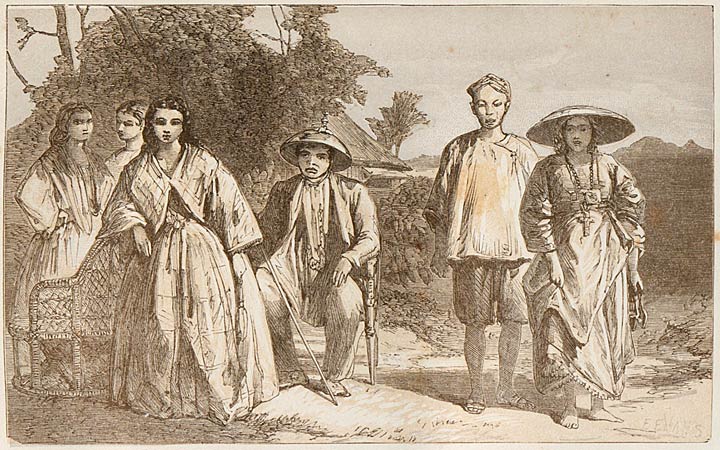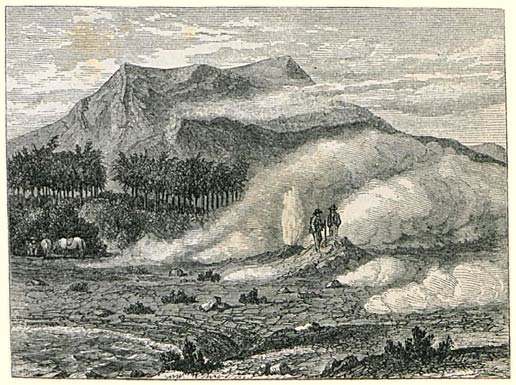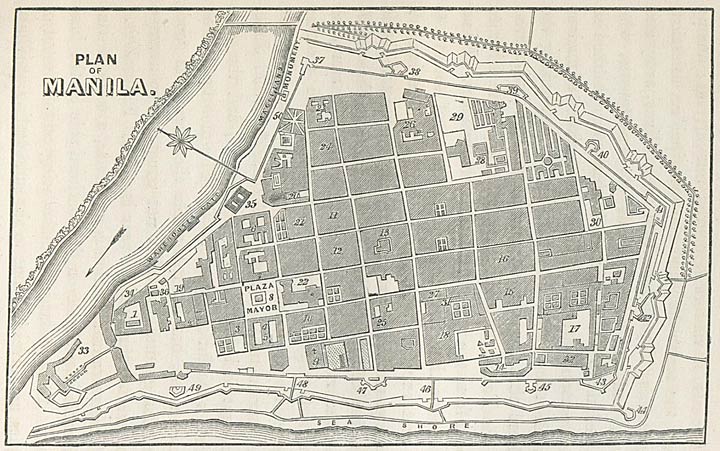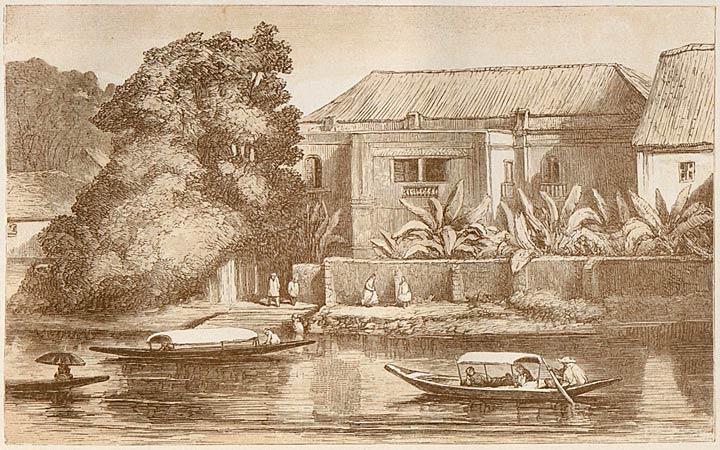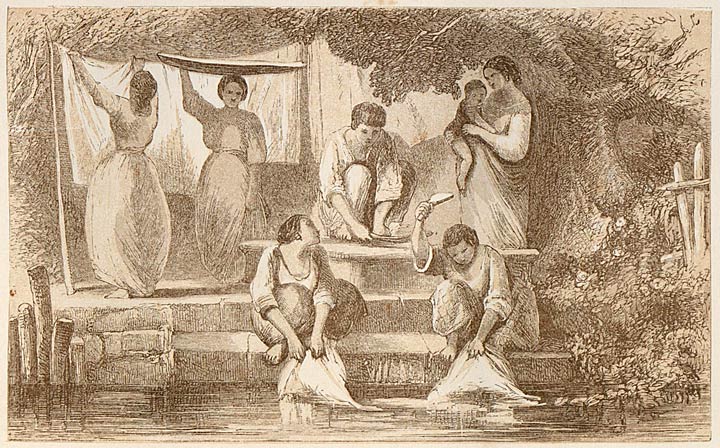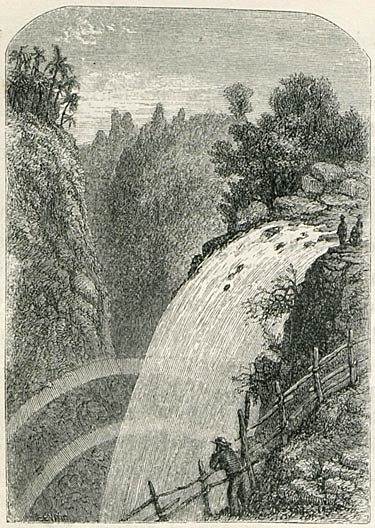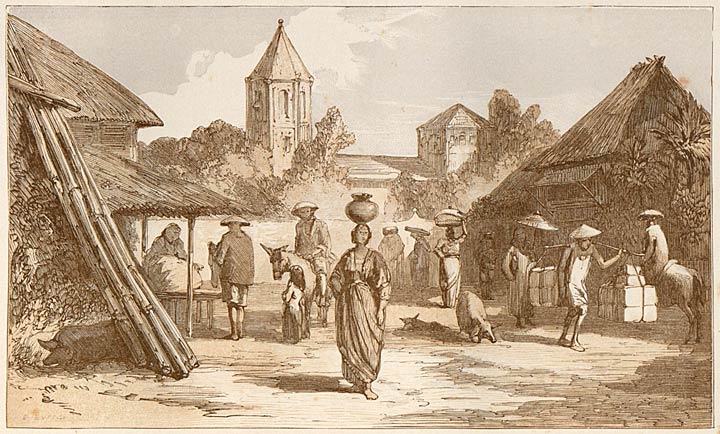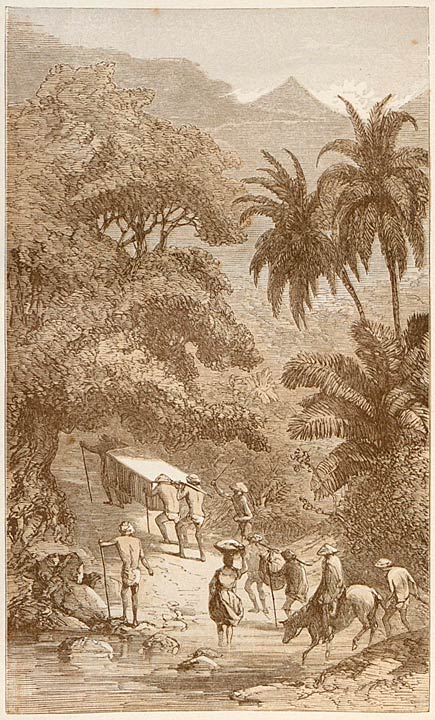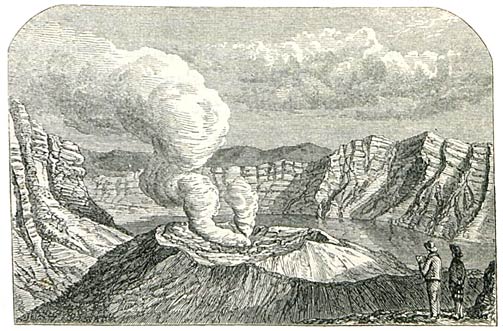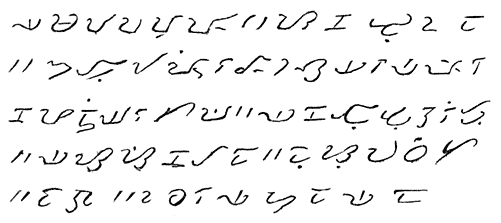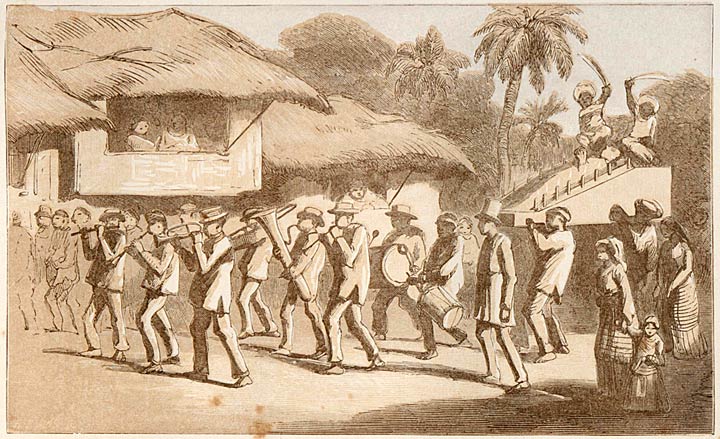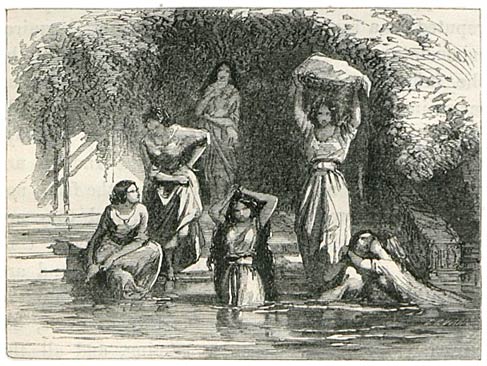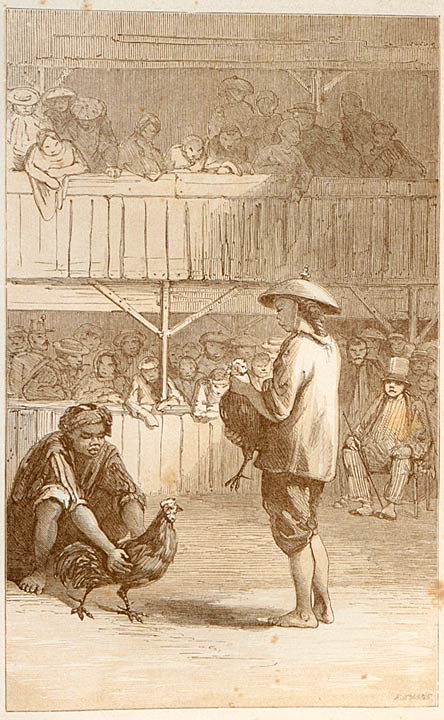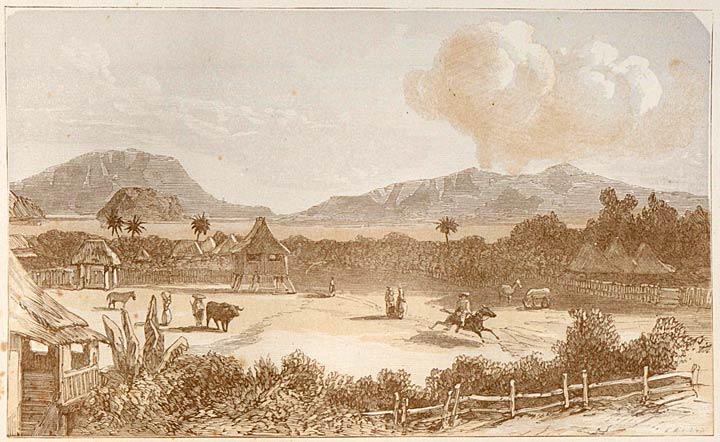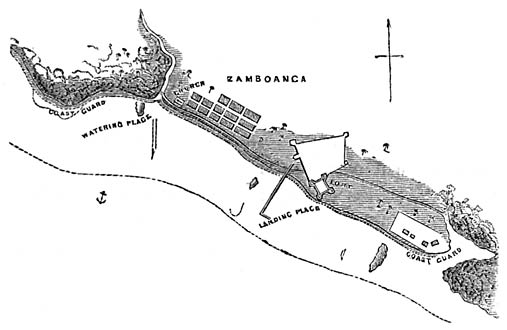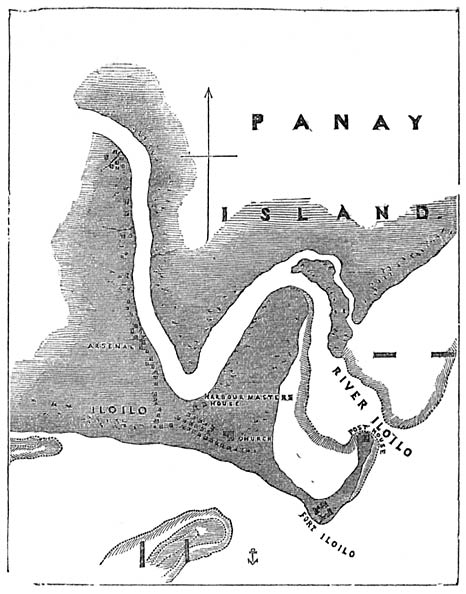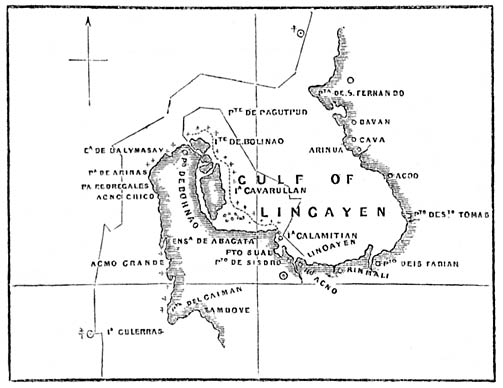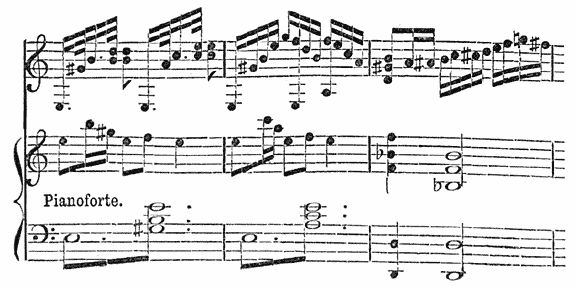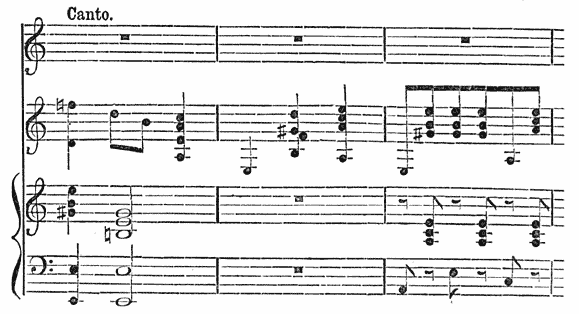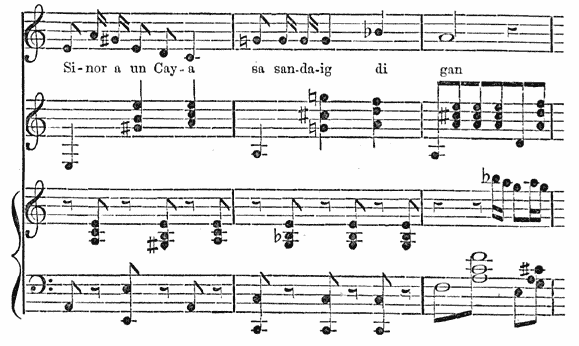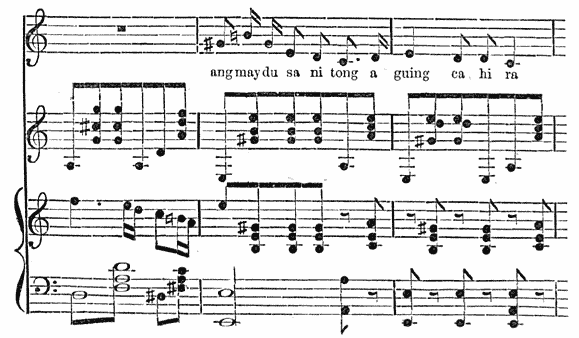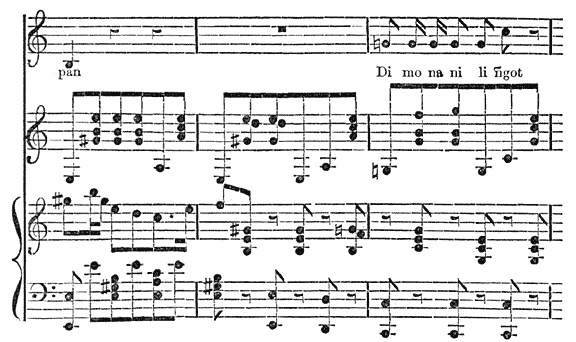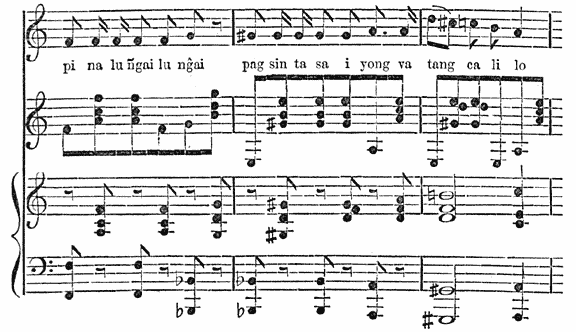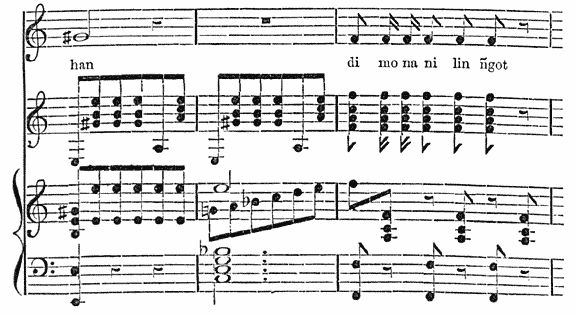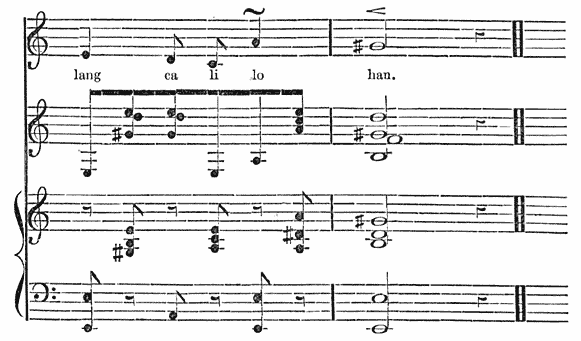Of the three ports lately opened to foreign commerce, Iloilo is the
most promising. The province of Iloilo is one of the most populous of
the Philippines. It contains more than half a million of inhabitants,
and though portions of the province are very thinly [355]peopled, there is an average exceeding 2,000
inhabitants per square league. Independently of the pueblos which I
visited, and of which some description will be given, Cabatuan has
23,000 inhabitants, Miagao 31,000, Dumangas 25,000, Janiuay 22,000,
Pototan 34,600, and several others more than 10,000 souls. The province
is not only one of the most numerously peopled, it is, perhaps, the
most productive in agricultural, the most active in manufacturing,
industry, and among the best instructed of the Philippines.1 It has extensive and cultivated plains and
forest-covered mountains; its roads are among the best I have seen in
the archipelago. At the entrance of the channel are a number of islands
called the Seven (mortal) Sins—Los Siete
Pecados. The large island of Guimaras limits the channel on the
south; it was visited by some of our party, who returned delighted with
the extensive stalactite caverns which they explored, reaching them
with some difficulty over the rocks, through the woods and across the
streams which arrested their progress. The forests are full of game and
the river Cabatuan abounds with crocodiles. There are many rivulets and
rivers which greatly assist the cultivator, and we found a good supply
of cattle. The ponies of Iloilo are among the best in the archipelago,
and [356]some attention is paid to the breeding of sheep.
A good deal of salt is made, and there is a considerable fishery of
trepang (sea-slug) and tortoises for the sake of the shells. But
the island is most renowned for the piña fabrics called nipas
and sinamays, some of which are of exquisite fineness and beauty; they
are largely exported, and their perfection has given them a vast
reputation even in Europe.
On the arrival of the Spaniards they found the district occupied by
painted Indians, full of superstitions, which, notwithstanding the
teachings of the Augustine friars, are still found to prevail,
especially at the time of any public calamity. They are among the best
formed of the Indians, speak a dialect of the Bisayan, which they
called Hiligueyna, but in the remoter parts another idiom named
the Halayo prevails. The Augustines boast of having converted
fifty thousand families in 1566, but they were not able to induce them
to cultivate their lands and to store their surplus produce, and the
locusts having desolated the district, in the two following years more
than half the population perished of hunger. But the missionaries made
no progress among the Negritos who dwelt in the wilder parts of
the mountainous regions, and who were joined by many desiring to escape
from the authority of the invaders. These savages have not unfrequently
attacked the villages of the converted Indians, but of late years have
found it more prudent and profitable to bring down their wax and pitch,
and exchange them for rice and garments. They have no general ruler,
but each [357]clan has its recognized head, and it is said
that, when perplexed as to choice of a successor to a departed chief,
they send deputations to the missionaries and ask their advice and
assistance to regulate their choice. Formerly the district was
frequently attacked by pirates, who committed great ravages and
destroyed several towns. In 1716 the Dutch attacked the fortress of
Iloilo, but were compelled to retire after a heavy loss both in killed
and wounded. There has been a great increase in the population, which
in 1736 numbered 67,708 souls; in 1799, 176,901; in 1845, 277,571; and
by the last census, 527,970, of whom 174,874 pay tribute. There is a
small number of Spaniards—of mestizos many, of whom the larger
proportion are sangleys, the descendants of Chinese fathers and
native mothers. The increase of the population must be great, the
census in 1857 giving 17,675 births, and only 9,231 deaths.
The approach to Iloilo is by a channel between a sandbank (which has
spread nearly a mile beyond the limits given in the charts) and the
island of Guimaras. The town appears adjacent as it is approached, but
the river by which vessels enter makes a considerable bend and passes
round close to the town. We observed a large fortification, but it had
not the means of saluting us, and we were therefore exonerated from the
duty of exploding H. M.’s gunpowder; but if not in the shape of
noisy salutations, the courtesies of the Spanish authorities were
displayed in every possible way towards the officers and [358]crew
of our frigate, for whose service and entertainment everything was
done. We were soon waited on by a gentleman from the British
vice-consulate. The vice-consul returned to Iloilo the day after our
arrival. It would indeed be well if all British functionaries possessed
as much aptitude, knowledge and disposition to be useful as we found in
Mr. Loney, to whom the commerce of the Philippines generally, and the
port of Iloilo especially, is under great obligations. To him, more
than to any other individual, the development of the trade of Panay
will be due.
From the Governor of Iloilo, Colonel José Maria
Carlès, especially I experienced great kindness. He was
Buffering under a sore affliction—for affliction holds sway over
every part of the world—the loss of an only and beloved son who
had preceded him as governor of the province and was an object of so
much affection that the people earnestly implored the Captain-General
to allow the father to succeed him, which was granted. It was touching
to hear the tales of the various displays of popular sympathy and
sorrow which accompanied the death and the interment of Don Emilio
Carlès, whom no less than fifty carriages followed to his grave
in Arévalo. I passed the village more than once with the
mourning father; at a time, too, when sorely suffering from sorrows of
my own, I felt the consolation which is found in remembering and
helping others to remember the virtues of the dead. These are their
best monuments, though not written on tablets of stone. [359]
The principalia of Molo came to invite us to a ball, and very
prettily the ball was got up. It is a most industrious locality; in
ancient times was a Chinese colony, and is now occupied by mestizos and
their descendants, most of them having a mingling of Chinese blood. The
pueblo has 16,428 inhabitants, of whom the mestizos are 1,106. It is
one of the busiest towns in the island, and everything has a prosperous
and active look. Some of the buildings have in the same apartment many
looms occupied in making the piña stuffs. The place was gaily
illuminated on occasion of the ball, and the gobernadorcillo made an
oration in Spanish to the effect that the locality had been much
honoured by our presence, and that the memory of the day would be long
preserved. Many of the mestizos keep their carriages, which were placed
at the disposal of our friends, and which fell into the procession when
music and firing of guns and muskets accompanied us through the town.
Molo is an island formed by two creeks, and entered by bridges on both
sides. I believe it is one of the few localities served by a secular
curate. It is about four miles from Iloilo, the road being good, and
many Indian houses are seen on both sides of the way. Almost all these
have their gardens growing plantains, cocoa-nuts, bread-fruits, cocoa,
betel and other vegetable productions. Sugar planting appeared to be
extending, and there are many paddy-fields and much cultivation of
maize.
The Governor and British vice-consul accompanied [360]us
in our pleasant excursions to the interior, during which we visited
some of the most populous pueblos of the provinces. We travelled in
comfortable carriages, the friars or the gobernadorcillos providing us
with relays of horses, and the convents were generally the places
appointed for our reception, in which we invariably found most
hospitable cheer. One day it was determined to visit Janiuay, and we
first stopped at Jaro, a pueblo of more than 22,000 souls. The roads
had their usual adornings: the Indian cottages exhibited their flags,
the equestrian principalia came out to escort us, and the native bands
of music went before us when we entered and when we quitted the
populous part of the town. Jaro is deemed the most opulent place in the
island of Panay. It was founded in 1584 or 1585. Cultivation extends to
some distance around it. It boasts of its stone bridge, more than 700
feet in length and 36 feet in breadth, the erection of which, as well
as the excellent roads by which the pueblo is approached, are due to
the munificence of a curate knighted by his sovereign for his patriotic
sacrifices. Though the country is level, the rich vegetation on the
banks of the streams and by the borders of the highway make the scenery
picturesque. The manufacture of fine stuffs and cotton, piña and
silk, is very considerable. These fabrics are exposed for sale at a
weekly market, held on Thursdays, which is crowded by people from every
part of the province, being the largest of the Iloilo marts. From Jaro
we proceeded to Santa Barbara, a pueblo of 23,000 souls. Here we were
received at [361]the convent of the Augustine friars, in whose
hands are all the cures of Iloilo, to one of whom we had the pleasure
of giving a passage to Manila, whither he was bound as the delegate to
the annual assembly of the fraternity. Here, too, other Augustine
friars visited us, all inviting us to partake of the hospitalities of
their spacious convents. Santa Barbara is a modern town, built in 1759,
and placed under the special protection of the saint whose name it
bears. It has shared in the general prosperity of the province: in 1820
it had no manufactures; but it has now a weekly market for the sale of
the produce of its looms, consisting principally of cottons,
sail-canvas, quilts, coverlets, &c. The forests furnish fine timber
for building and for cabinet work, and are crowded with wild bees,
whose wax and honey form a considerable article of traffic. Excellent
were the carriages and horses of the friars. Our next resting-place was
Cabatuan, somewhat larger than Santa Barbara. Cabatuan was founded in
1732. It is on the banks of the river Tiguin; sometimes nearly dry, and
at others deluging the country with its impetuous torrents. The
numerous crocodiles make fishing unsafe; and the navigation even of
small boats is often interrupted, either by the superfluity or
insufficiency of its waters. There is a large production of rice and of
cocoa-nut oil for lighting. From Cabatuan we went to Janiuay, which was
the limit of the day’s journey, and of our visit to the interior.
It is called Matagul in the ancient maps of the province, and
[362]has about the same number of inhabitants as
Santa Barbara. The convent and church are on a slightly elevated
ground, and offer a pretty view of the pueblo and surrounding country.
Many of the women are engaged in the labours of the loom, but
agriculture is the principal industry of the neighbourhood. We had
hoped to visit the Dingle mountain, one of whose caves or grottos is
said to present the character of a temple of fantastic architecture,
adorned with rock crystal and exhibiting masses of marble and alabaster
which form its walls; another cave is formed of granite, which abounds
in the locality: but we had to return to Iloilo to meet the principal
people at a late dinner, succeeded as usual by a ball. The
Governor’s house being at some distance from the town, we were
kindly accommodated at that of one of the native merchants,
conveniently situated on the quay of the river. Several of the friars,
who had been our hosts, were the guests of the merchants; and the kind
hospitality we experienced did not justify the constant expression of
courteous regrets for the inadequacy of the entertainment, the blunders
of the native servants (sometimes amusing enough), and the contrasts
between the accommodations of Europe and those which a remote Spanish
settlement in the Philippines could afford; but there was so much of
courtesy, good breeding and cordiality that it was impossible to feel
otherwise than grateful and contented, and, after all, in this world to
do all we can is to discharge every duty. [363]
The next day we made our arrangements for visiting the different
pueblos on the coast, and, starting in our carriages soon after
daybreak, we passed through Molo and Arévalo to Oton.
Arévalo has some celebrity in the annals of the Philippines, and
had a special interest for the Governor, as here had been lately
displayed the affection of the Indians for his son, whose funeral they
had honoured with such special marks of sympathy and regret.
Arévalo was formerly the residence of the governor—built
by Ronquillo in 1581, who gave it the name of his birth-place. Molested
by the Indians, attacked by pirates and the government quite
disorganized, it was for a long time abandoned; and the seat of
authority being removed to Iloilo, Arévalo presents few signs of
activity: there are about 8,000 inhabitants in this district. At Oton
we saw from the Augustine convent an interesting ceremony. It was on a
Sunday; and on quitting the church the inhabitants were summoned by
beat of drum to attend the reading of a proclamation of the government.
They were all in their holiday garments, and men, women and children
formed a circle round one of the native Indian authorities, who, in a
loud voice, read in the Bisayan tongue the document which he had been
ordered to communicate to the people. There was perfect silence during
the reading, and a quiet dispersion of the crowd. Fortifications are
erected along the coast, and a great variety of manufactures were
brought to us for examination. A good deal of English cotton twist is
sold, which [364]forms the warp of most of the fabrics.2 There were rugs of silk and cotton; varieties of
coloured ginghams; tissues, in which the fibres of the abacá and
the piña were mixed with our cotton thread, whose importation
is, however, confined to the colours which the Indians are themselves
not able to dye. Oton has nearly 23,000 inhabitants. I observe the
proportion of births to deaths is as nearly four to one, and that while
there are five births to one marriage, the deaths exceed the marriages
by less than one-third, so that the increase of population must be very
great. In 1818, it was less than 9,000. Tigbauan, with its 21,000
inhabitants, was our next halting place. Its general character
resembles that of Oton. Rice is the principal agricultural production,
but the women are mostly employed in weaving stuffs, which find markets
in Albay and Camarines. We were accompanied from the Augustine convent
by a friar of Guimbal, who obviously exercised much influence over his
brethren and over the whole community. His conversation was both
entertaining and instructive. He had a good stud of horses, a handsome
carriage, and he certainly employs his large revenues with generous
hospitality. Not to repeat what has been repeated so often, the
Indians, on the [365]whole line of our journey, made a holiday
time for our reception, which partook everywhere of the character of a
public festivity. After the principalia had accompanied us to the
convents, and received their thanks from me, and their dismissal from
the Governor and the friar, a number of little girls were introduced,
to whom the service of the table and attendance on the guests were
confided. There was a strange mixture of curiosity, fear and respect in
their deportment; but they gathered round my arm-chair; their bright
black eyes looked inquiringly into my face, and asked for orders; while
one, who seemed rather a pet of the ghostly father, put her hand into
the curls of my white hair, which she seemed to consider worthy of some
admiration: but the friar told me they were discoursing among
themselves whether it was possible I could be a general and a great
man, who had no gold about my clothes; I was not dressed half as finely
as the officers they had been accustomed to see. They were very proud
of some of the piña garments they wore, and one after another
came to display their finery. They took care to supply me with cigars,
and that light should be ready whenever the cigar was extinguished, and
when we sat down to our well-furnished repast, several of them were at
hand to remove the plates, to provide others, and to see that we were
well provided with the delicacies of the day. On our way back to
Iloilo, we learnt that the principalia of Molo were to escort us in
their carriages to our domicile; they were waiting for us in the main
road, so that we made together quite a procession. They had
[366]before invited Captain Vansittart and the
officers of the Magicienne to their ball, and many attended,
keeping up the dance to an early morning hour.
We left Iloilo the following day. The Governor and several of the
principal people, among whom was a large group of Augustine friars,
accompanied us with music to the ship. Three loud shouts of grateful
hurrah broke forth from our decks, cordially responded to by our
hosts—and so farewell! and all happiness to Iloilo.
I have sent to Sir William Hooker, for the museum of the Royal
Gardens at Kew, sixty specimens of woods grown in the northern and
western districts of the island of Panay and the province of Antique,
of which the most notable are—the molave, the most useful
and compact of the Philippine woods, and applied to all purposes of
building; bancaluag, for fine work; duñgon, for
ship-building and edifices; bago-arour, building and
cabinet-work; lumati, a species of teak; guisoc, a
flexible wood for ships and houses; ipil has similar merits;
naga, resembling mahogany, used for furniture; cansalod,
planks for floors; maguilomboy, for the same purpose;
duca, baslayan, oyacya, for ship-building;
tipolo, for musical instruments; lanipga, a species of
cedar used for carving and sculpture; bayog, spars for masts and
yards; bancal, for internal roofs and carving;
malaguibuyo, for flooring; ogjayan, flexible for joints,
&c.; lanitan, guitars, violins, &c.; janlaatan,
furniture; lauaan, spars for shipping; basa, in large
blocks for building and shipping; talagtag, cabinet-work;
nino, the bark [367]used for dyeing both red and
yellow; bacan, spars; panao, a medicinal wood used for
sore eyes by the Indians; banate, a fine and solid box-wood,
used for billiard-maces, has been exported to Europe;
bancolinao, ebony; casla has a fruit resembling a French
bean, whose oil is used by the natives for their lamps; jaras,
for construction of houses. It will be observed that all these bear
their Indian names, which are generally applied to them by the
Spaniards.
As regards the commercial position and prospects of the whole of the
central and southern islands of the Philippine Archipelago, the most
satisfactory details which have reached me are those furnished in 1857
by the Vice-Consul of Iloilo, Mr. Loney, to the Consul of Manila, from
which I extract the following information.
That portion of the Philippines called the Bisayas may be generally
described as including the whole of the islands to the southward of
Luzon, though, strictly speaking, it is understood to comprehend only
those of Samar, Leyte, Panay, Negros, Cebu, Bohol (with their
dependencies, Tablas, Romblon, Sibuyan, &c.), and four
provinces—Misamis, Caraga, Zamboanga, and Nueva
Guipuzcoa—of the important island of Mindanao, next to Luzon the
finest and largest of the archipelago.
The administration of the revenue of the Bisayas was formerly in
charge of a separate Government Intendency (Gobierno
Intendencia de Bisayas) established in the city of Cebu; but this
being abolished [368]in 1849, all the provinces, as regards
revenue, are now equally under control of the Superintendencia at
Manila. While, however, the provinces and districts of Luzon (with the
exception of Cavite, La Isabela, Nueva Viscaya, El Abra, San Mateo, and
La Union) are presided over by civil functionaries (alcaldes mayores), those of the Bisayas are governed by
military officers (gobernadores militares y politicos)
of the rank of captain to that of colonel, assisted in most instances
by a lieutenant-governor, a civilian, and usually a lawyer, who takes
cognizance of all ordinary civil and criminal cases.
The Bisayan group is mostly inhabited by a race resembling, in all
essential characteristics, the Tagálog, and other Malayan races
of Luzon. Their language may be called a dialect of the Tagálog,
though rather harsher in sound, and neither so copious, so refined, nor
so subjected to grammatical rules, as this latter idiom. The Bisayan
has more Malay words than have the dialects spoken in Luzon. The
natives of these islands and those of Luzon imperfectly comprehend each
other, though their languages are evidently derived from the same
parent stock.
The Bisayas furnish a hardy, seafaring race; but, as a rule, the
general tendency to indolence, attributed to the Philippine
“Indian,” applies, in a perhaps greater degree, to the
inhabitants of the whole southern group, and constitutes at present, in
the absence of any available means of coercion, one of the principal
obstacles to a more rapid extension of agriculture by the introduction
of European capital. [369]
The christianized population of the Bisayas may be estimated as
follows:—
| Samar |
118,000 |
| Leyte |
115,000 |
| Romblon |
16,600 |
| Panay:— |
|
|
Capiz |
135,000 |
|
Iloilo |
450,000 |
|
Antique |
80,000 |
| Cebu and Bohol |
385,200 |
| Negros |
108,000 |
| Calamianes |
18,000 |
| Mindanao:— |
|
|
Misamis |
44,500 |
|
Caraga (Surigao) |
15,300 |
|
New Guipuzcoa (Bislig and Davao) |
11,200 |
|
Zamboanga |
12,000 |
| Total |
1,508,800 |
This estimate does not include the unsubdued tribes inhabiting the
mountains in the interior, some idea of the number of which may be
formed from a note of those ascertained to have existed in 1849, in the
undernoted provinces:—
| Misamis |
66,000 |
| Samar |
25,964 |
| Leyte (not ascertained). |
|
| Negros |
8,545 |
| Panay |
13,900 |
| Cebu |
4,903 |
| Total |
119,312 |
The largest number of unsubjected tribes (principally Mahomedan)
inhabit Mindanao, the total population of which is generally asserted
to amount to nearly one million souls. [370]
The island of Panay, advantageously placed towards the centre of the
Bisayas group, is distant at its nearest point—that of Potol, in
lat. 11° 48´ N., long. 122° W. of Greenwich—180
miles in a right line from Manila. Its shape is nearly triangular, and
it has a circumference of about 300 miles. It is the fifth in size of
the Philippine Islands, coming in this respect after Luzon, which has a
circumference of 1,059 miles; Mindanao, 900; Paragua, 420; and Samar,
390; but, though smaller than the islands just named, it is, next to
Luzon, the most populous of the archipelago, if Mindanao, with the
doubtful population of independent tribes above-mentioned, be left out
of the question.
Panay is divided into the three provinces of Capiz, Antique, and
Iloilo, which together contain a population of about 665,000.
Capiz occupies the whole of the northern portion of the coast of
Panay, for a distance of seventy-seven miles.
Its limits towards the interior may be defined by a curved line,
commencing from a little to the eastward of Point Bulacan, passing by
the Pico de Arcangel, in the Siaurágan Mountains, and continued
westward to Pandan, on the coast. Its chief town is Capiz, situated on
the river of the same name. Though broken towards the southern and
western portion by an irregular series of mountain chains, the greater
part of the territory of Capiz consists of extensive low-lying plains,
which produce rice in great abundance. It possesses a few good
harbours, particularly [371]that of Batan; and Capiz itself,
situated at the confluence of the rivers Panay and Capiz, affords
secure anchorage. Its tribute-paying population is officially reported
to be 135,000 souls.
Antique takes up the western side of the island, to an extent of 84
miles—from Point Naso on the south to Pandan on the
north—is of triangular shape, and limited on the north by the
province of Capiz, on the south and east by that of Iloilo, and on the
west by the sea. Antique is very mountainous, and, being comparatively
thinly inhabited, does not at present produce much for export,
especially as the greater development of its resources is retarded by
the want of good harbours, of which it does not possess one along its
whole line of coast. At its chief town and port, San José de
Buenavista, a breakwater is in process of construction, which, if
completed, will give a great impulse to the trade of the province, by
enabling vessels to load there at all seasons of the year. At San
José foreign whaling and other vessels not unfrequently call for
water and fresh provisions. The number of its inhabitants, exclusive of
the remontados and monteses, who occupy the
mountainous districts, is computed to amount to 80,000 souls.
Iloilo extends over the south-eastern portion of the island, is also
of triangular form, bounded on the north by Capiz, on the west by
Antique, and on the south-east by the arm of the sea which separates it
from the island of Negros. This, the largest, richest and most peopled
of the three provinces, deserves more particular notice. [372]
Iloilo, its chief town, and the residence of its governor, distant
254 miles in a direct line from Manila, and placed by Spanish
hydrographers in lat. 10° 48′ W. of the meridian of San
Bernardino, is situated near the south-eastern extremity of the island,
close to the sea, on the border of the narrow channel formed by the
island of Guimarás, which lies opposite to it at a distance of
two miles and a half from the Panay shore.
The town is built principally on low, marshy ground, subject to
tidal influence, partly fronting the sea, and partly along the left
bank of a creek, or inlet, which runs towards Jaro, and after
describing a semicircle again meets the sea near Molo. Although the
principal seaport and seat of the government of the province, its
population is not so large as that of many of the towns in its
vicinity. It does not at present exceed 7,500, while Jaro, Molo and
Oton, towns in its immediate neighbourhood, possess 33,000, 15,000 and
20,000 respectively. This comparative scarcity of inhabitants is
principally owing to the want of space for further extension on the
narrow tongue of land on which the town is chiefly built. This obstacle
to its further increase should in time cease to exist, as efficient
measures are being taken to draw the population more inland; among
others, the erection of a new government house and public offices at a
more central point; the contemplated removal of the present church to a
more advantageous and open site, beyond the tongue of land alluded to;
and the convergence [373]at this place of new and more direct roads
(now in course of construction) leading to and from the adjacent
populous towns.
Notwithstanding the drawback of limited space, the progress in size
and importance of the town has of late years been very marked, while
the European residents, who, in 1840, numbered only three, now, in
1857, amount to 31 in Iloilo, and 30 in the remaining towns of the
province. A considerable portion of this number arrived during the past
two years, and the effect of this increase of Europeans, though their
number is so small, is already visible in the construction of new
buildings, and projects for the erection of many others. The rise in
house property may be illustrated by the fact that the house in which
the vice-consulate is established—constructed of wood with a
palm-thatched roof—is subject to a rental of 33 dollars per
month, or about 80l. per annum. The value of land for building
lots has also augmented in proportion.
The population of the province is given officially as 511,066; but
there is reason to think it considerably exaggerated, and that 400,000,
or at most 450,000, would be nearer the real amount.
The harbour of Iloilo, though well protected and naturally good, is
not without inconveniences, capable, however, of being obviated with
little trouble, and, provided with one of the excellent charts lately
issued by the Comisión
Hidrográfica (and, if approaching from the north,
with a pilot), large vessels may enter with safety. [374]
The island of Guimarás, which is twenty-two miles long by
three in breadth, forms in front of Iloilo a sheltered passage, running
nearly north and south, of a width varying from two miles and a half to
six miles, with deep water and good anchorage. The entrance to this
passage from the south is a good deal narrowed by the Oton shoal
(Bajo de Oton), which stretches for a considerable
distance from the Panay shore, and contracts for about a mile in length
the available channel at this part to the breadth of about two miles.
This, however, will be no obstacle for large ships during the
south-west monsoon (especially when the channel is properly buoyed
off), the passage being perfectly clear as far as it extends; and with
a contrary north-east monsoon they can work or drag through with the
tide, keeping well over towards Guimaras, the coast of which is clear
with deep water close in, anchoring, if necessary, on the edge of the
shoal, which affords good holding-ground, and, being of soft sand, may
be safely approached. The whole of this coast, protected as it is by
Guimaras, the Panay shore, and, in a considerable degree, by the island
of Negros, offers secure anchorage in the north-east monsoon; and
situated on the south-west portion of Guimaras, the fine port of
Buluanga, or Sta. Ana, of easy access and capable of admitting vessels
of the largest tonnage, will afford shelter under almost any
circumstances. The approach to the opposite or northern entrance is
generally made by the coasting vessels through the chain of small
islands (Gigantes, [375]Pan de Azucar, Sicógon, Apiton,
&c.), called collectively the Silanga, which lie off the
north-east coast of Panay and afford an excellent refuge for a
considerable distance to the vessels engaged in the trade with Manila
and the southernmost Bisayas. But though there is good anchorage among
these islands, particularly at Pan de Azucar and Tagú, it would
be more prudent for vessels of large burden, in cases where there is no
practical acquaintance with the set of the tides and currents, to take
the outside channel between the Silanga and the island of Negros. After
passing the Calabazas rocks and Pepitas shoal and making the castle or
blockhouse of Banate (formerly erected, like many others along the
Philippine coasts, for defence against the pirates of the Sooloo Sea),
the route is due south until sighting a group of seven remarkable
rocks, called the “Seven Sins,” for which a direct course
should then be made, the lead being kept going to avoid the Iguana Bank
(which is well marked off on the charts referred to), and on getting
south of the Iloilo Fort vessels of a certain tonnage may enter the
creek, or, if too large, should bring up on the east side of the fort,
where they are protected from the wind and the strength of the tides.
The depth of water on the bar at the entrance to the creek is about
five fathoms at low water; but at a short distance farther inside the
water shoals to fifteen feet at low water, and then deepens again. The
rise and fall being six feet, a vessel of 300 tons, drawing, when
loaded, sixteen to eighteen feet, can [376]easily obtain egress
with a full cargo. A dredging machine employed to clear away the mud
which has been allowed to accumulate at the shallower parts near the
entrance, would enable ships of almost any burden to complete their
cargoes inside. The Santa Justa, a Spanish ship of 700
tons, loaded, in 1851, part of a cargo of tobacco inside the creek, and
finished her lading outside.
It should be mentioned that, the banks of the creek being of soft
mud, there is little or no risk to be apprehended from grounding.
Proceeding about a mile and a half up the creek (which varies in
breadth from half a mile to three-quarters of a mile, and affords
complete protection from wind and sea), the coasting crafts bring up at
the jetties of their respective owners, and have the great advantage of
discharging and loading at the stores without the necessity of
employing boats.
Beyond this point, the creek stretches as far as Molo. Formerly the
coasting vessels used, when necessary, to go on to Molo, but the
drawbridge through which they had to pass having got out of repair, and
the present bridge (now in very bad condition) affording no means of
passage, they remain at Iloilo, to which place the Molo traders have
had to transfer their warehouses.
The export trade of Iloilo, hitherto confined to the port of Manila
and the adjacent islands, is at present chiefly carried on by four
Spanish firms resident at Iloilo and owners of the better class of
native craft sailing from this port; but to these [377]are
to be added a considerable number of mestizos, or half-castes,
principally of Chinese descent, living at the neighbouring towns of
Molo and Jaro, several of whom are also owners of vessels, and employ
considerable sums in the trade.
The principal products exported are leaf tobacco, sugar, sapan-wood,
rice in the husk (or paddy); hemp and hides, besides other articles in
lesser quantity, including horns, beche-de-mer, mother-of-pearl shell,
beeswax, canes, &c., and a considerable amount of native
manufactured goods. Leaf, or unmanufactured tobacco, is at present the
article of most importance, and the one which the Spanish traders have
found most lucrative. It is purchased by them from the small native
growers, and shipped to Manila for exclusive sale to the government, at
prices fixed by the factory appraisers, according to the size and
quality of the leaf. From Iloilo some 30,000 quintals were shipped last
year for Manila, and from Capiz 20,000, giving about 50,000 as the
exportable quantity of the leaf produced in Panay per annum.
The export of tobacco to Manila, until the year 1845, did not amount
in this province to more than 10,000 quintals per annum; but in that
year the agent of a Manila firm having raised the usual low prices
given by the Iloilo traders from 10 rials to an average of 20 to 21
rials for the three first qualities, the export, in 1847, had rapidly
reached 24,000 quintals.
The attention of the government being directed to its growing
importance, it was resolved to institute [378]a system of
“Coleccion,” through the governor and a staff of
collectors, similar to those “Collecciones” that are
established at Cagayan, La Union, and Nueva Ecija. By this system, the
purchase for, and export to, Manila by private traders, though not
positively interdicted (as is the case in the provinces just named),
was so much prejudiced and interfered with by the unequal competition
with the government (to which the private buyers had ultimately to sell
what they shipped), that the total export from Iloilo fell during the
six years from 1848 to 1853 from 25,000 to 18,900 quintals. In this
latter year the coleccion was withdrawn. In 1853 a company formed at
Madrid was allowed the exclusive privilege of the manufacture and
export of cigars and leaf tobacco to foreign markets. A large and
expensive stone-built factory was erected near Iloilo, the manufacture
of cigars organized, and purchases of the leaf effected, and, latterly,
the company’s operations were extended to the cultivation of the
plant in different parts of the province. A clause, however, in its
charter rendered it incumbent on the company to furnish the factories
at Manila, if required, with a considerable yearly amount both of leaf
tobacco and cigars, equal, if necessary, to the amount annually derived
in the province from other sources. As a consequence, the requirements
made for the Manila factories (purposely augmented, it is said, by the
hostility of the then Intendente de Hacienda to the company) were to
such an extent as virtually to deprive it of all power to act on its
own account; [379]and, after an existence of nearly three years,
its embarrassments were such as to compel its extinction, with the loss
of a considerable portion of the capital originally sunk. Had the
authorities at Manila favoured its development, the result, though
necessarily cramped by the defective principle inherent in all
monopolies, might have been favourable, as, with the liberty to
manufacture for, and ship to, foreign markets, it could have afforded
to give good prices, and might have extended the culture of the tobacco
plant. It is a suggestive fact in connection with this subject that one
of the Europeans formerly in the employ of the company has since had
cigars manufactured for local consumption, which he has sold at 8
dollars per thousand, nearly, if not quite, equal in quality to the
“Imperiales” occasionally manufactured at the factory at
Manila at 25 dollars per thousand.
Since 1853, and coexistent with the company’s operations, the
purchase and shipment of tobacco by private individuals have been
resumed on their original footing; and, while the amount so shipped has
steadily, though very gradually, increased, prices have maintained a
slight upward tendency. The maximum rates, however, which the local
traders can afford to pay the native growers are not high enough to
bring about a rapid extension of planting, or induce these latter to
give time and labour enough to improve the quality of a plant, the
proper culture of which requires special attention, and the application
of more capital and intelligence than they have it [380]in
their power to bestow. The Iloilo shippers complain of the arbitrary
manner in which the classification of qualities is made at Manila, and
of the fact that, even after delivery of the tobacco at the government
stores, it is held entirely at their risk until examined, repacked and
ready for shipment to Spain. The qualities shipped at Iloilo are
classed as 1st (of which a very small quantity is produced under the
present system), 2nd, 3rd, 4th, and 5th; and any rejected by the
examiners at Manila as under the 5th quality is retained and burnt,
though no allowance on such portion is made to the vendor. The rates
given by the factory for the above qualities are 7·75,
6·75, 5·25, 4, and 3 dollars per quintal respectively.
The seedlings are planted out in January, and the greater part of the
crop comes forward in May and June. The soil of the greater part of the
Bisayas is favourable to the growth of tobacco. The island of Negros
formerly produced about 8,000 quintals, of very good quality, which the
Iloilo traders, through their agents, were in the habit of purchasing
from the independent tribes inhabiting the interior; but the measures
taken by the present governor to bring the latter into subjection
having resulted last year in the slaughter of several hundreds and the
dispersion of the rest, supplies from this source are at present
stopped. Cebú produces about 15,000 quintals, of rather inferior
quality. At Leyte, particularly in the district of Moasin, tobacco of
very excellent quality and colour is grown, but it does not pay to
produce in large quantity for export to [381]Manila, and is
consequently used almost exclusively in the Bisayas, where it is much
appreciated. Samar also grows tobacco for local consumption. The
manufacture of cigars is allowed throughout the Bisayas, but not for
sale at Manila or elsewhere.
For the present the export of tobacco from Panay and the other
islands possesses little direct interest for British or foreign
merchants, the transactions with government, as at present conducted,
not being of a satisfactory nature. It is, however, almost superfluous
to say, that if the existing government monopoly of tobacco were
abolished (substituted by a system of farming out lands, a direct
territorial tax on the quantity under cultivation, or a duty on
exports), and both the free manufacture for, and direct shipment to, a
foreign market allowed, the export from Panay would immediately become
of great importance to the foreign trade. The soil of a very great
portion of the island being well adapted for the cultivation of the
plant, the export, under the stimulus of much higher prices and the
consequent employment of more and better-directed capital, would be
capable of great expansion, particularly if, as would in all
probability be the case, the culture were undertaken by Europeans, and
the present system of small patches cultivated by natives gave place to
estates on a large scale, as in Cuba. The benefits which would accrue
to the native population by the opening up of larger sources of
industry need not be pointed out. [382]
The subject of the suppression of the existing monopoly is a most
important one for the Philippines; and it is to be hoped that the
government at Madrid, encouraged by the beneficial results of the
abrogation, in 1819, of the monopoly in Cuba, will at no distant date
resolve to overcome the difficulties which at present surround the
question, particularly as its solution becomes yearly more urgent, and
more called for on the part of both Europeans and natives.
Sugar, as an article of export, may be said to be as yet
comparatively in the germ. By an abstract taken from notes of province
cargoes given daily by the Boletin Oficial of Manila,
it is seen that nearly 12,000 peculs went forward last year from this
province to Manila, of which it may be estimated that about 3,000 were
brought over from the Isla de Negros, and sent on to the capital as
Iloilo sugar. So great has been the stimulus given by the high prices
for this article which have lately ruled, that the quantity exported
from Iloilo alone will not fall short of 20,000, or say, with
contributions from Negros, about 25,000 peculs, or nearly 1,600 tons;
and, were the present rapid extension of planting to continue in the
same ratio for three years, the amount exportable would in that time,
as there is no want of available land, reach about 80,000 peculs, or
5,000 tons, subject to further augmentation from other sources, should
foreign vessels commence loading at this port.3 At the
island of [383]Negros, from whence the voyage occupies from six
to ten hours, the soil of which is eminently fertile, and which
possesses immense tracts particularly adapted for the growth of sugar,
a similar extension of culture is in progress, in spite of the great
drawback of the comparative sparseness of its population, which alone
prevents it from yielding sugar and hemp in larger proportion than any
other province in the Philippines. At present Negros produces about
14,000 peculs, or nearly 900 tons, of sugar, of which more than
two-thirds go to Manila direct, and the remainder by way of Iloilo.
There is a further available source from whence sugar (in the event of
foreign vessels loading at Iloilo) would be derivable at the contiguous
island of Cebú, which produces upwards of 90,000 peculs, or
5,695 tons, for the Manila market, and is within easy distance of two
to three days’ sail from Iloilo.
The effective nature of the stimulus given by the present prices
will be comprehended when it is considered that the value of Iloilo
sugar, which in previous years up to 1855 had generally ranged from 2
to 2·10 dollars per pecul in the Manila market, is now
5·68¾ dollars per pecul at Manila, against 3·2 to
3·3 dollars, with 25 per cent. for prem. on silver, or equal to
4·06 dollars to 4·21½ dollars here, and as long as
the rate obtainable at Manila does not recede below 3 dollars per pecul
of 140 lbs., the extension of planting will be continued. Of late
years, owing to the disproportionally low prices paid at Manila, sugar
planting had in many districts been [384]abandoned as
unremunerative, but during the past and present year it has rapidly
increased, particularly since the introduction of a more economical
kind of furnace, in which the refuse cane is used to some extent in
place of the large amount of wood formerly consumed.
The very defective nature of the process employed by the native and
mestizo planters does not allow of the production in Iloilo of a
superior class of sugar, and all that leaves for Manila may be
described as “ordinary unclayed;” but the grain is usually
very good, and on undergoing the ulterior processes in England and
Australia, it yields a fine strong sugar, and has been much approved of
for boiling purposes at the Glasgow refineries. Were a better system of
crushing and boiling introduced here, sugar of an excellent quality
would be produced, and it is greatly to be desired that a few Europeans
with sufficient capital and experience would form estates in this
neighbourhood. At present there is not a single iron-mill in the
island. The unclayed sugars of the Philippines in ordinary times, even
under the present defective and consequently expensive mode of
production are held to be the cheapest in the world. The only Europeans
now engaged in the cultivation of sugar in this quarter are a French
planter, at Negros, who produces an excellent sugar (which always
commands upwards of 1 dollar a pecul more than ordinary Iloilo), and a
planter of the same nation, in this province, who has lately commenced
on a limited scale. [385]
Taking the prices quoted above as a basis (4·21½
dollars here against 5·68¾ dollars at Manila), the
difference in favour of this, the place of production, is now
1·47¼ dollar per pecul; but supposing the additional
47¼ cents to be given here by the foreign exporter in order to
secure such share of the crop as would be required to load a direct
vessel, there would still remain an important saving of 1 dollar per
pecul, or say 17½ per cent. less than the prime cost at Manila.
The freight to Manila at present charged by the coasting vessels is 50
cents per pecul. The bulk of the sugar crop is delivered from February
to March.
Sapan-wood is exported in considerable quantity from the province of
Iloilo. It is chiefly produced in the vicinity of the southern coasting
towns, Guimbal, Miagao, and San Joaquin (the farthest within twenty
miles of Iloilo), from whence the greater part is brought round by sea
to Iloilo for exportation to Manila, and the rest shipped direct from
Guimbal. Last year, as reported in the imperfect notes of the Boletin Oficial, 32,723 peculs, or 2,045 tons, were shipped to
Manila, and 789 peculs from Antique.
The high prices lately obtained at Manila have led to the formation
of new plantations, which will still further increase the exportable
amount. A large quantity is sent on yearly to Singapore and Amoy, and
forms the bulk of the cargoes of such vessels as load at Manila for the
former port.
The quality of the Iloilo sapan-wood would be much better were the
natives to abstain from the [386]practice of cutting down a large
portion before the trees are sufficiently grown. When allowed to obtain
its proper development, it is said to be quite equal or superior to
that of Misamis or Bolinao, at present the best qualities brought to
the Manila market. As both sellers and brokers endeavour to deliver the
wood as soon as possible after it is cut, the loss in weight on the
voyage to Manila is said to be sometimes as much as 12 to 14 per cent.
The present price of sapan-wood delivered at Iloilo is, with the
addition of 25 per cent. for cost of silver, 1·08 dollar per
pecul against the Manila rate of 1·75 to 1·875 dollar,
leaving a considerable margin in favour of vessels loading here for a
foreign market. The freight to Manila is 31·25 cents per
pecul.
Hemp (so called, though in reality the product of a variety of the
plantain) produced in Iloilo is chiefly of a long, white fibre, equal
to what is known in the London market as “Lupiz,” used in
the manufacture of the native fabrics, and at present little attention
is paid to it as an article of export. But though Iloilo produces
little or no surplus hemp, the small coasting craft annually bring here
some 350 tons from the neighbouring islands and provinces of Leyte,
Samar, Negros, Camarines, and Albay, received at those places in
exchange for the paddy and native goods of this province.
Both Leyte and Samar now produce large quantities of excellent hemp
for the Manila market, particularly the former island; and the voyage
hither throughout the greater part of the year is so short [387](at
present vessels take five to six days in going and two to return) that
were the native traders to find a ready market at Iloilo, at prices
relatively equivalent to those of Manila, it is more than probable that
a considerable additional quantity would be directed to Iloilo instead
of to the capital.
At the island of Negros the production is increasing very rapidly, a
large quantity having been planted during the past year, several
pueblos and districts possessing tracts of upwards of 100,000 and
200,000 plants, which will come into use during the next two years, and
as the plant is remarkable for its great propagative power, the
obtainable quantity should increase in duplicative ratio every year.
The export of hemp from the Isla de Negros amounts at present to 13,000
to 14,000 peculs, or about 850 tons, per annum, chiefly from the port
of Dumaguele, on the eastern side of the island.
When it is recollected that in 1831 the whole export of hemp from
the Philippines did not amount to more than 346 tons, and that in 1837
it had already reached 3,585 tons, and that during 1856 no less than
22,000 tons left Manila for the United States and Europe, some idea may
be formed of the future of this valuable article at the fertile island
of Negros, even with the drawback already alluded to of a scanty
population.
I am the more inclined to dwell on the facts regarding Negros, as
from its close proximity it may almost be considered, in the event of
direct exports from Iloilo, as an integral part of the island of
[388]Panay. The amount of hemp shipped from Capiz
last year was 6,458 peculs, or 400 tons, chiefly, however, of an
inferior description made from the fibres of the pácul, a
wild variety of the plantain. As this inferior hemp, however, commands
a remunerative price, I believe the plant producing the genuine article
is now being more generally cultivated at Capiz. The rate for hemp here
may be quoted at 5·375 dollars, or, with 25 per cent. for cost
of silver, 6·715 dollars per pecul, against the Manila rate of
7·75 to 8 dollars. Freight to Manila, 50 cents per pecul.
Rice in the husk, or Paddy, is an important item in the agriculture
of Panay, though at present of little actual interest in relation to
the foreign trade. The yearly production of the province of Iloilo,
though nothing definite is ascertained regarding it, may be supposed to
be 850,000 cavans, of which probably 40,000 are exported to the
neighbouring islands and Manila. Capiz may produce about 900,000
cavans, and export about 100,000 in the same way. Antique also
contributes a considerable quantity for the consumption of the island,
and exports upwards of 15,000 cavans. These amounts, however, must be
looked upon as guesses at the actual quantities consumed and
shipped.
The paddy exported is chiefly conveyed in small schooners
(pancos and barotos) to the neighbouring islands of Leyte
and Samar, and also to Camarines and Albay, in exchange for hemp and
cocoa-nut oil (the latter obtained at Leyte), which are either
[389]brought to Iloilo for sale or taken on to
Manila. When prices at Manila leave a sufficient margin (which they
generally do throughout the year), some amount of paddy goes in that
direction, forming a portion of the cargo of the vessels leaving for
the capital.
The paddy shipped from Iloilo is chiefly drawn from the vast plains
of Dumangas, Zarraga, Pototan, Santa Barbara and Barotac-viejo. Were a
large portion of land brought under cultivation, the increased surplus
of this grain would be available for an export to China, in which
foreign vessels might be employed, as they frequently are at Sual, in
Pangasinan; and it may not unreasonably be surmised that, in the course
of time, ships frequenting the port of Iloilo, and proceeding to China,
will naturally take part of their cargoes in rice, and thus give a
further impetus to its cultivation. At present, owing to the late
scarcity of rice in Camarines and Leyte, the price of paddy at Iloilo
has risen to 10 rials per province cavan, which is equal to one and a
half of the measure (cavan del rey) used at Manila.
The other articles shipped from Panay likely to be of importance to the
direct export trade are:—
Hides—Buffalo and cow, of which the last year’s exports
to Manila were 128 tons from Iloilo, 60 tons from Capiz, and 24 tons
from Antique. Prices here (very high at present) may be quoted at 5
dollars to 8 dollars for buffalo, and 10 dollars to 14 dollars for cow
hides, per pecul. [390]
Horns—A limited quantity from the three provinces. Price, from
2 dollars to 3 dollars per pecul.
Cowries—430 cavans were shipped last year from Capiz, 42 from
Antique, 33 from Iloilo. This article, formerly worth at Manila
2·50 dollars to 3 dollars per cavan, has lately risen to 15
dollars.
Gum Mastick—2,359 peculs, or 147 tons, were sent last year
from Capiz to Manila, where its value is usually from 1·50
dollar to 3 dollars per pecul.
Mother-of-Pearl Shell—A small quantity is obtainable at this
port, and at Capiz, chiefly brought from Sooloo, viâ
Zamboanga, and from the adjacent islands of the Silanga. Quotation here
usually about 18 dollars to 22 dollars per pecul.
Rattans or Canes—Used in packing produce at Manila; 401,000
went forward from Capiz in 1856, 104,000 from Iloilo, and 97,000 from
Antique.
Mat Bags—Made from the leaf of the sago palm, used also for
packing; 155,850 were shipped to Manila, from Capiz, in 1856.
Beeswax—A few peculs are annually shipped from the three
provinces to Manila.
Gutta-Percha—Some quantity of this valuable substance has been
sent from hence to Manila, but, either owing to adulteration, or
ignorance of the proper mode of preparation, it has not obtained an
encouraging price. The tree yielding it, called by the Bisayans
nato, abounds in this province, and in Guimarás, and if
it prove to be the real Isonandra gutta of the Straits and
Borneo, should hereafter become of considerable importance. The
monopoly [391]of shipment from Manila, granted to Señor
Elio, has an injurious effect on the production of this article.
Timber—for building, and woods, of various descriptions, for
furniture, abound in Panay, and the islands of the Silanga and
Guimarás are peculiarly rich in valuable trees. From thence are
obtained the supplies for Iloilo and the neighbouring towns, and for
the construction of vessels, occasionally built at Guimarás,
where one of 350 tons is now (1857) on the stocks; but as yet little
impression has been made on the immense quantity to be obtained.
Of other articles, which are either not adapted for European
markets, or as yet produced in insignificant quantities, I will merely
enumerate—cocoa, of excellent quality; arrowroot; vegetable
pitch, of which a considerable quantity is sent to Manila; wheat, which
grows freely in the elevated districts of the island, and of which
1,125 bags were sent from Iloilo and Antique in 1856; maize,
beche-de-mer, dried vegetables (beans, &c., a large amount), sago,
cotton, tortoise-shell, deer-skins, ginger and gold-dust.
Gums, dyes and drugs, of various descriptions, abound in Panay, and
a scientific examination of the many products of this nature, of which
little or no use is made, is a great desideratum. It should be borne in
mind that most of the minor articles above-mentioned are also produced
by the neighbouring islands, and may be therefore obtainable in
increased quantities, should the anticipation of Iloilo becoming in a
great measure the emporium of the trade of the Bisayas be realized in
future. [392]
Of the mineral wealth of the island little or nothing definite is
known. Gold is found in the bed of a river near Abacá, in this
province, and near Dumárao, in Capiz. Iron and quicksilver are
said to have been discovered, the former at various places in the
island; and coal is reported to exist in Antique; but these are points
which have hitherto received little attention. In a journey to the
interior, made with the governor of Iloilo, through the Silanga, along
the whole north-eastern portion of the province, and as for as the
Capiz boundary, near Dumárao, Mr. Loney was shown several
specimens of ore, apparently containing a large percentage of iron.
With reference to this expedition, Mr. Loney adds from personal
experience, his testimony in confirmation of the accounts of the
fertility of the island, and the prosperous commercial future which
seems to await it. The roads in general are tolerably good until the
setting in of the heavy rains from August to October; but there is at
present in many cases a want of efficient bridges, which impedes the
free transit of produce towards the coast. The island does not afford a
superficies large enough for the formation of any considerable streams,
and the principal and only important river in this province, the
Jalaur, which meets the sea near Dumángas, and by which a large
quantity of paddy is conveyed to the coast, and forwarded to Iloilo, is
only capable in the dry season of bearing craft of very small
burden.
The system of purchases of produce at Iloilo is, as usual in nearly
all the provinces, to employ brokers, [393]or personeros, who buy the produce from the native and mestizo
growers and dealers at the different pueblos in the interior and along
the coast, and receive a commission of five per cent. on the amount
delivered. It is generally necessary to make advances through these
brokers against the incoming crop, in order to secure any quantity, and
such payments in advance are always attended with a certain amount of
risk. The price of the article to be received is commonly fixed at the
time of paying over the advance, and for any overplus of produce
received from the grower the current rate at the time of delivery is
generally accepted. In the event of a permanent direct trade being
established, it is likely that the practice will in time become more
assimilated to that which obtains at Manila, i. e., shippers may
be able to purchase or contract on the spot from mestizo, Chinese or
Spanish holders of produce, either directly or at the expense of a
trifling brokerage.
Nearly all payments being made to the natives in silver—as
they will seldom agree to receive gold—it is necessary to place
funds here in the former coin.
Besides the natural products above mentioned, Panay produces a large
quantity of manufactured goods, both for export and home consumption.
Of these the greater and more valuable portions, included under the
native term sinamay, are made of the delicate fibres of the leaf
of the pine-apple (piña), either pure or mixed with silk
imported from China, and a proportion of the finer sorts of British
manufactured cotton thread. The process [394]of separating the
piña fibres and sorting them in hanks previous to manufacture,
and the manufacture itself, requiring a great deal of time and care,
the pure piña textures are proportionally dear. Some of the
finest sorts are of exquisitely delicate texture. Those mixed with
silk, though not so durable, are cheaper, and have of late years been
gradually superseding the pure piña fabrics, although these
latter are still much worn by the more wealthy natives and mestizos. To
such an extent, indeed, is silk from China now imported into this
province, that, according to the statement of the principal Chinese
trader in this article at Manila, fully 400,000 dollars worth is
annually sent to Iloilo from the capital. Latterly the price of silk
has risen from 40 to 45 dollars per chinanta of ten catties to 80 and
90 dollars, or say from 450 to 900 dollars per pecul.
The greater part of the piña and mixed piña, silk and
cotton fabrics is used for shirts for the men, and short jackets or
shirts for the women. The price varies considerably, according to the
fineness or coarseness of the texture, and the greater or less amount
of mixture, some pieces for the men’s shirts costing as much as 7
dollars (the value of which, elaborately embroidered at Manila, is
sometimes enhanced to 50 or 100 dollars), and the inferior sorts 50
cents to 2 dollars per piece of 4½ varas. The figured work of
these fabrics is generally of European cotton sewing thread or coloured
German and British yarn, and the stripes of thread, yarn or coloured
and [395]white silk. Textures of a cheaper character are
also extensively made of hemp and other fibres, costing two to four
rials each. There is also an extensive manufacture of coloured silk and
cotton goods for “sarongs” (similar to those, principally
of Bugis manufacture, used throughout the Malayan Archipelago),
cambayas, and silk and cotton kerchiefs for the head. The better class
of silk fabrics are excellent both for solidity of texture and finish.
Those of cotton are principally made of German and British dyed twist,
and of native yarn manufactured from cotton grown in several districts
in this province, and also imported from Luzon. The finer sorts are
well and closely woven, and the ordinary kinds of a cheap description
adapted for more common use. Trouserings, of cotton and mixed silk and
cotton, are manufactured to some extent, but the Manchester and Glasgow
printed drills and plain grandrills are fast displacing them as
articles of general consumption. Among the other manufactures may be
enumerated table-cloths, napkins, towels, coverlets, cotton rugs,
&c. Of embroidery work, which enters so largely into the industry
of the provinces of Bulacan and Manila, there is little done in Iloilo,
with the exception of the working of sprigs of flowers on the lace and
network mantillas, which are much used by the female population in
attendance at church.
In addition to the goods above mentioned, a considerable amount of
coarse fabrics is made of the leaf of the sago palm, of hemp, and of
other fibres. [396]These are known in the Manila market as
Saguran, Guináras and Medrinaque, and are
shipped to the United States and Spain, and in lesser quantity to
England. Saguran and guináras are largely used at the government
factories in packing the leaf tobacco forwarded to Spain. Price, from
25 to 37½ dollars per pecul of 7½ to 8 varas. Medrinaque
has for some years past been exported in increasing quantity to the
United States and Europe, where it is chiefly used for stiffening
dresses, linings, &c. This article is principally made at Samar,
Leyte and Cebú, from whence, in case of direct export, it will
be obtainable for shipment. Present prices in the Manila market for
Cebú 20 dollars, Samar 18 dollars, per fifty pieces.
Considering that the Philippines are essentially an agricultural
rather than a manufacturing region, the textile productions of Iloilo
may be said to have reached a remarkable degree of development. Nothing
strikes the attention at the weekly fairs held at the different towns
more than the abundance of native goods offered for sale; and the
number of looms at work in most of the towns and villages also affords
matter for surprise. Almost every family possesses one of these
primitive-looking machines, with a single apparatus formed of pieces of
bamboo, and, in the majority of the houses of the mestizos and the
well-to-do Indians, from six to a dozen looms are kept at work. The
total number in this province has been computed at 60,000; and though
these figures may rather over-represent the [397]actual quantity, they cannot be much beyond it.
All the weaving is done by women, whose wages usually amount to from 1
to 1·50 dollar per month. In general—a practice
unfortunately too prevalent among the natives in every branch of
labour—these wages are received for many months in advance, and
the operatives frequently spend years (become, in fact, virtually
slaves for a long period) before paying off an originally trifling
debt. There are other workwomen employed at intervals to “set
up” the pattern in the loom, who are able to earn from 1 to
1·50 dollar per day in this manner. It should be added that
Capiz and Antique also produce, in a lesser degree than Iloilo, a
proportion of manufactured goods.
Notwithstanding the increasing introduction of European piece goods
into Panay, it is gratifying to observe that the quantity of mixed
piña stuffs exported rather augments than otherwise with the
gradual addition to the general population and the increased means
derived by it from the rapidly progressive development of the resources
of the islands. Judging from the values of the quantities taken on in
almost every vessel leaving for the port of Manila, the annual export
in that direction would not seem to be at all over-estimated if put
down at 400,000 dollars. The goods represented by this amount are not,
it should be remarked, used in the city and province of Manila alone,
but enter also into the consumption of Pampanga, La Laguna, Camarines
and other provinces [398]of Luzon. In addition to the export of
piña to the capital, about 30,000 dollars worth of cotton and
silk sarongs and handkerchiefs are sent yearly to Camarines. Some
quantity is also exported to Leyte and Samar, but anything like an
approximate value of the goods so shipped cannot be given. In fact the
subject of statistics here has received so little attention, either
from the authorities or from the local traders themselves, that on
terminating his notice of the principal articles exported from Panay,
Mr. Loney regrets to find himself unable to supply a reliable account
of their united value. The Estadistica de Filipinas,
issued in 1855, and compiled at Manila by the Comision
Central, nominated for that purpose, gives, from data probably
obtained from the very imperfect custom-house entries, the following as
the value of the imports into Manila from Panay in 1854:—
| Iloilo— |
Dollars. |
Dollars. |
|
Iloilo |
264,416 |
|
|
Guimbal |
39,850 |
|
|
——— |
304,266 |
| Capiz— |
|
Capiz |
181,681 |
|
|
Calwo |
114,124 |
|
|
Jbajay |
7,095 |
|
|
Batan |
15,147 |
|
|
——— |
318,047 |
| Antique— |
|
Antique |
18,866 |
|
|
San José |
2,925 |
|
|
Cagayancillo |
3,061 |
|
|
Culasi |
1,199 |
|
|
——— |
26,051 |
|
648,364 |
[399]
But the most cursory examination of what must be the probable value
of the more important articles exported, even adopting the probably
understated quantities given in the preceding remarks, leads to the
conclusion that the export to Manila from the province of Iloilo alone
must equal or exceed the amount given by the Estadistica as the total sum for the provinces.
Presuming the quantities and values to be as undernoted, there will
result of
|
Dollars. |
| Piña, silk, hempen and other
manufactures |
400,000 |
| Tobacco, |
30,000 |
quintals, |
average 3½ |
dolls. |
105,000 |
| Paddy, |
30,000 |
cavans, |
1 |
|
30,000 |
| Sugar, |
20,000 |
peculs, |
3 |
|
60,000 |
| Sapanwood, |
33,000 |
|
1 |
|
33,000 |
| Hemp, |
5,000 |
|
5½ |
|
27,500 |
| Hides, |
2,050 |
|
total value |
19,800 |
| All other articles roughly valued
at |
45,000 |
|
720,300 |
To which sum if the exports to other islands and provinces be added,
it may be fairly inferred that the total value of exports from Iloilo
cannot fall short of 800,000 dollars; an amount which does not seem at
all out of proportion to the number of its inhabitants. These figures,
if Capiz be put down at 700,000 dollars, and the Antique exports be
taken at 70,000 dollars, will give to the yearly exports from Panay an
aggregate value of upwards of 1,500,000 dollars.
But even the imperfect data of the Estadistica
would afford some indication of the rapid rate of [400]increase in the exports from the three
provinces. For example—
|
Dollars. |
| 1852—value of products from Iloilo, Capiz,
and Antique |
271,335 |
| 1853
|
302,605 |
| 1864
|
648,369 |
Or an augmentation in 1854 of considerably more than double the
amount given in 1852. While on this subject, it may be added that the
local custom-house has unfortunately registered no complete details of
the exports for 1856, though it has commenced doing so for 1857. These
details are, however, relatively of much less importance than those of
direct foreign shipments, which will demand future attention.
Mr. Loney thus adverts to the present state of the Iloilo import
trade:—
“Although perhaps the greater part of the clothing for the
population of Panay is furnished by the native looms, still a large
amount of European goods is annually imported from Manila. I estimate
that on the average (as far as can be judged where anything like
positive data are totally wanting) about 30,000 dollars to 40,000
dollars per month are now brought in goods to the port of Iloilo by the
mestizo and Chinese traders, and subsequently disposed of at the larger
markets of Jaro, Molo, Oton, Mandurriao, &c., from whence a certain
portion finds its way into the interior. This branch of the trade is as
yet principally conducted by the mestizo dealers of Molo and Jaro, who,
on completing their purchases of native-made [401]goods for the Manila market, embark with them
(in numbers of from six to ten, fifteen, and sometimes twenty) in the
coasting vessels leaving for the capital. The returns for these
speculations they generally bring back in foreign (principally British)
manufactures, purchased at cheap rates from the large Chinese
shopkeepers at Manila. The sale of these goods by retail here is still
conducted in the rather primitive way of conveying them from place to
place on certain fixed days. In this way goods that appear to-day at
the weekly fair or market of Jaro, are subsequently offered for sale at
Molo, Mandurriao, Oton, or Arévalo. They are carried to and from
the different pueblos in cumbrous, solid-wheeled vehicles, drawn by
buffaloes and oxen, a mode of conveyance which, during the wet season,
is attended with a good deal of delay and risk. The Chinese dealers at
Molo, and a few small traders at Iloilo, have, however, commenced
opening permanent shops, and it is probable that the number of these
will gradually increase throughout the province, though, as the fairs
are also the central point of attraction for all the products within a
certain radius of each pueblo, and thus bring together a large
concourse of people, the weekly transfer of piece and other goods from
one place to another must still continue to a great extent. There are
about thirty Chinese permanently established at Molo (mostly connected
with others at Manila, either as partners or agents), and two or
three at Jaro. A certain number are also employed in voyaging to and
from Manila with goods, after [402]realizing which here they
return for a fresh parcel, either taking the returns in money or
produce. One of the Chinese traders at Molo, who is well supplied from
the capital, sells goods to the amount of some 30,000 dollars or 40,000
dollars a-year. Owing, however, to too much competition among
themselves and the other traders, I do not, judging from the prices at
which they usually sell, think that their profits are in general at all
large. The fact that the mestizo dealers look for their principal
profit to the piña goods which they take to Manila, and are
comparatively less solicitous to obtain an advance on their return
goods, has also a tendency to keep prices low, as compared with Manila
rates.
“As is the case in most of the provinces where the Chinese
have penetrated, there exists a more or less subdued feeling of
hostility towards them on the part of the natives, and a tendency, both
among the mestizos and Spanish, to regard them as interlopers. But
though the government at Manila has been repeatedly urged to withdraw
them from the provinces, and confine their trading operations to Manila
alone, it does not seem inclined to adopt a measure which would prove
injurious to the general trade of the colony. It is true that if a
portion of the Chinese were induced to become agriculturists (for which
purpose alone they were originally admitted to the provinces), great
benefit would accrue in the shape of an increased outturn of produce;
but as yet their numbers in the interior are too few to enable them to
cultivate the ground on a large scale, and in [403]small isolated bodies they would not have
sufficient security from the ill-will of the natives.
“The principal articles of foreign manufacture imported into
this province are—handkerchiefs (printed) of bright attractive
colours, wove and printed trouserings, ginghams, fancy cambayas, plain
grandrills, white shirtings, gray shirtings and gray longcloths, gray
twills (29 inches, both American and English), bleached twills, lawns,
white jaco-nets, striped muslins, cotton sewing thread, cotton sarongs,
cotton twist, or yarn, and woollens (not in much demand). There is also
sale for hardware, glassware and earthenware, and for other minor
articles.
“Import duties are leviable at Iloilo on a valuation either by
tariff, or according to the market rate at time of entry. They are the
same as those charged at Manila, viz.:—
|
By foreign ships. |
By Spanish
ships. |
| On most descriptions of foreign
goods |
14 per cent. |
7 per cent. |
|
With the following exceptions:—
Cambayas, ginghams, handkerchiefs, &c., entirely of black, purple,
and blue, with or without white grounds |
25
|
15
|
|
Yarn of same colour |
50
|
40
|
|
Ditto, red, yellow, rose and green |
free |
free |
| Machinery, gold and silver, plants and
seeds |
free |
free |
| Made-up clothing, boots, &c. |
50
|
40
|
| Bottled ale or porter |
25
|
20
|
| Wine, liquors and vinegar |
50
|
40
|
| Spirits |
60
|
30
|
“Tropical productions, similar to those of the Philippines,
[404]are not admitted to consumption, nor fire-arms,
without a special licence.
“All goods may be bonded on payment of 1 per cent.
“Export duties on produce of every description to foreign
ports are, 3 per cent. by foreign, and 1½ per cent. by Spanish
ships, with the following exceptions:—Hemp, 2 per cent. by
foreign, and 1½ per cent. by Spanish ships; tortoise-shell,
mother-o’-pearl shell, 1 per cent. by foreign, and 1 per cent. by
Spanish ships; rice, 4½ per cent. by foreign, and 1½ per
cent. by Spanish ships.
“No duties are charged on goods arriving or departing
coastwise by coasting vessels.
“Port dues.—No special charges are yet fixed for vessels
arriving at Iloilo, but they may be stated as about equivalent to those
levied at Manila, viz.:—On foreign vessels arriving and leaving
in ballast, 18¾ c. per ton; with cargo inwards or outwards,
34¾ c. per ton; with cargo both inward and outward, 37½
c. per ton.
“Wages are moderate at Iloilo:—Labourers, 12½ c.
to 18¾ c. per day; carpenters, 18¾ c. to 25 c. per day;
caulkers, 25 c. per day.
“Fresh provisions are obtainable at cheap rates.
“The weights and measures in use for produce are—the
quintal, of 4 arrobas, or 100 lbs. Spanish, equal to 101¾ lbs.
English; pecul of 100 catties, or 140 lbs. English. The cavan of rice
(cavan de provincia) is equal to one and a half of the
Manila cavan, or cavan del rey; it weighs about 190
lbs. English, and [405]measures 8,997 cubic inches. The pesada, by
which sapan-wood is sold, weighs 13 arrobas 13 lbs., or nearly
2½ peculs.
“The currency is nominally the same as in Manila, but silver
dollars have to be paid for nearly all purchases, gold being of
difficult circulation.
“From the preceding outline of the trade of this port, you
will gather that at present, with an annual export of about 1,600 tons
of sugar, upwards of 2,000 tons of sapan-wood, and 350 to 400 tons of
hemp, it is (considering the quantity which the foreign shippers would
be able to secure) capable of furnishing cargoes for two foreign
vessels of moderate tonnage; and next year, as regards sugar, which
will form the bulk of the cargoes of foreign vessels loading here, the
supply will probably be doubled. The more important question, however,
as regards the foreign trade of Iloilo, is not as to the actual
quantity of produce (still so very limited) which this island may
furnish, but whether the concentration of produce from the neighbouring
islands and provinces will in reality be brought about.
“A review of the facts regarding the southern Philippines
would seem to lead to a conclusion in the affirmative. With Leyte and
Samar giving a combined annual export of 4,000 tons of hemp,
Cebú upwards of 5,000 tons of sugar, Negros a (rapidly
expanding) product of about 900 tons of sugar and 800 tons of hemp, and
without taking into account the possible supply of hemp which may be
drawn from South Camerines and from Albay (which [406]produce by far the largest part of the existing
export of hemp from the Philippines, and are, during the north-east
monsoon, within a shorter distance of Iloilo than Manila), it seems in
no way hazardous to assume that, on relatively equal prices being
obtainable here, Iloilo will attract in the course of time a gradually
augmenting proportion of the products which now go on to Manila. It may
be further conjectured that Misamis (which yields a considerable
quantity of remarkably good hemp), Caraga, and the other provinces of
Mindanao, may also in time contribute their share to the products
obtainable at a port which their traders must pass on their way to
Manila, though the full development of the intercourse of the
neighbouring islands with Iloilo will greatly depend on the amount of
European imports with which this latter port should gradually be able
to supply its new customers. The opinion of the natives themselves,
though not to be taken as a guide, may still serve in some measure as
an index of what may be looked for. In talking on the subject to the
owners of the small craft whose cargoes of hemp have been brought to
Iloilo, they have frequently said, ‘If foreign vessels come here
and give higher prices, much more hemp from Leyte and Camarines will
come to Iloilo.’
“Cebú producing rice and manufactures for its own
consumption, there is at present little communication between it and
Iloilo; but it is encouraging to learn that one of the partners of the
most enterprising Spanish firm at this place intends proceeding both to
[407]Cebú and Leyte, to establish, if
practicable, a commercial connection, with the ulterior view of getting
both sugar and hemp sent to this quarter.
“It is also a favourable symptom that the trade of the
contiguous islands is more and more attracting the attention of some of
the foreign firms in Manila. The American houses (generally the first
in enterprises of this kind) have already, through Spanish intermedia,
established agencies at Negros, Leyte and Cebú, for the purchase
of hemp and sugar, and it is stated from Manila, on apparently good
authority, that one of them has lately advanced a sum of 170,000
dollars for this purpose, the distribution of which should have a
stimulating effect on production, and thus give a collateral aid to the
future exports from Iloilo.
“Considering the great advantages which would accrue from the
establishment of lines of small merchant steamers between the islands,
the fact that the government have lately given orders to commence
working the extensive coal districts existing at Cebú is not
without importance. The subject of steam communication for the
archipelago is attracting attention at Manila, and it is not improbable
that in a few years the islands will be connected in this way in a
manner which will greatly tend to their advantage.
“It should have been previously mentioned that the voyage from
Iloilo to Manila during the north-easterly monsoon (from November to
March) usually occupies the better class of square-rigged vessels in
[408]the trade from ten to fifteen days, and from
four to six days on the return voyage. Owing to the protection afforded
by the group of islands forming the Silanga, and by other harbours on
the route, vessels do not (as is usually the case between the ports on
the northern part of the more exposed coast of Luzon and the capital)
lay up during the stormy months from September to November; and
communication, though less frequent during these months, is seldom
altogether suspended for any length of time with Manila. On the
average, a vessel leaves for the capital every eight to twelve
days.”
I add a few further extracts from a report on the trade of 1858,
with which Mr. Loney has favoured me, and which strongly exhibits the
growing importance of Iloilo.
“The import trade, in direct connection with British and
foreign houses, has increased during the past year to a degree which
could not have been anticipated. Formerly it did not exceed 7,000
dollars in amount; but now, during a period of two years, it has
reached fully 140,000 dollars, and is likely to increase much more in
future as the capabilities of the market for taking off an important
quantity of manufactures become more fully known.
“Owing to the existence of a stock of foreign articles at
Iloilo, obtainable by the native dealers as a general rule (and as a
consequence of the more direct manner in which they reach their hands)
at cheaper prices than from the Chinese shops at Manila, many of the
native, and even some of the Chinese traders, find [409]the
advantage of making their purchases on the spot instead of in Manila,
and some of the former have ceased altogether to undergo the expense
and loss of time they formerly incurred in proceeding to Manila to lay
in their stocks, while others make voyages to the capital less
frequently than before, and send on their piña goods under the
care of friends or agents; consequently, the trade is beginning to be
conducted in a less primitive manner than in previous years, when each
small trader brought on his goods himself, purchased at high rates from
the Manila shopkeepers. Dealers from Antique, from the island of Negros
and from Leyte now also find at Iloilo a stock of goods sufficient to
supply their wants. Another beneficial effect is, that those who buy
wholesale at Iloilo are enabled to dispose of their goods to the small
dealers, or to their agents, who distribute them over the interior, at
lower prices than formerly. Goods are thus saleable, owing to this
greater cheapness, at places in the interior of the island, where they
were formerly rarely bought, and the natural consequence is, a
considerable increase of consumption. The concurrent testimony of all
the older residents in the province is, that during the last few years
a very marked change has taken place in the dress and general exterior
appearance of the inhabitants of the larger pueblos, owing in great
measure to the comparative facility with which they obtain articles
which were formerly either not imported, or the price of which placed
them beyond their reach. In the interior of the houses the same
[410]change is also observable in the furniture and
other arrangements, and the evident wish to add ornamental to the more
necessary articles of household uses; and those who are aware how
desirable it is, from the peculiarly apathetic nature of the natives,
to create in them an ambition for bettering the condition of themselves
and their families, or emulating that of others, by placing within
their reach the more attractive and useful articles of European
production, will at once recognize in these facts the beneficial
tendency of increased and cheaper imports.
“With regard to duties derivable from imports, we must
consider the more or less remote probability of direct imports from
Europe or China to Iloilo. It needs very little acquaintance with the
gradual and hesitative processes of trade to be aware of the slowness
with which they adapt themselves to new channels of communication.
Especially is this the case in reference to these southern islands,
from the previous commercial seclusion in which they had been
kept—a seclusion so great that it may be safely asserted that the
island of Panay, with its 750,000 inhabitants, is scarcely known, by
name even, in any of the commercial marts of Europe, America, or even
of Asia. Consequently, it affords no ground for surprise that no direct
transactions in imports have taken place. It must be recollected that
the years 1857–58 have been eminently unfavourable for new
commercial enterprises of any kind, owing to the depressed state of
trade in all the markets of the world. This state of depression, though
still felt, is, [411]however, drawing to a close, and the Iloilo
market, among others, will doubtless attract the attention of European
manufacturers and capitalists, though some time must necessarily elapse
before a sufficient number of shippers can be found to send
consignments of such a varied nature and assortment as would be
required to make up a cargo to suit the wants of Panay and the
neighbouring islands. Already consignments have arrived by way of
Manila, which were made up specially for the Iloilo market; and this
circumstance, and the fact that the Manchester manufacturers are
beginning to take an interest in the Iloilo demand, fully warrant the
belief that before long consignments from Europe, by the way of Manila,
will take place on an important scale, and pave the way to direct
shipments to Iloilo. Though it is almost useless to prognosticate in
cases of this kind, where so many circumstances may occur to retard or
accelerate the development of a new market, still I have no hesitation
in affirming it to be much more than probable, that in the course of
two years from this time Spanish vessels will arrive from Liverpool
direct, or touching and discharging part of their cargoes at Manila,
more particularly as by that time direct exports will have taken place,
and the sugar crop be raised to a point which will render it easy for
the vessels arriving with piece goods to obtain return cargoes of
sugar, sapan-wood and hides, all of which products, it is unnecessary
to say, can be obtained at Iloilo much more cheaply than in Manila.
[412]
“It is also probable that direct imports from China will take
place sooner than from Europe. The employment of raw Shanghai silk is
much greater at Iloilo than in any of the other Philippine provinces,
and the consumption amounts to fully 30 peculs per month, worth, on an
average, 600 dollars, silver, per pecul, or say 18,000 dollars per
month.
“The export trade from Iloilo direct to foreign markets is, in
fact, evidently the primary event on which the commercial fate, so to
speak, of the Bisaya Islands depends. The chief obstacle, in addition
to those mentioned above, which has retarded its commencement has been
the extreme smallness of the yield of sugar. In 1855–56, the
Iloilo crop, including some quantity received from the island of
Negros, scarcely reached 12,000 peculs, and, instead of increasing, it
had been declining in consequence of the discouraging effect of the
miserable price of 1·875 to 2 dollars per pecul of 140 lbs.; all
that could be obtained for it after incurring the expense of sending it
to Manila. In 1856–57, under the stimulus of higher prices, the
yield amounted to 35,000 to 37,000 peculs. In 1857–58, these high
prices had a still more stimulating effect on the planting of cane, and
it was calculated that the crop would yield at least 50,000 peculs; but
an excess of rainy weather reduced the actual outturn to about 30,000.
The present crop, however, of 1858–59 has escaped the danger of
rain, and it is computed that it will yield about 80,000 peculs from
January to July next. Some estimates place it as [413]high
as 100,000 peculs, but in this I think there must be exaggeration.
“The yield of sugar at Iloilo (leaving out of the question the
crop of Isla de Negros, which is now computed to produce 30,000 peculs,
and that of Antique, 20,000, both available for the Iloilo market)
having fortunately reached the above amount, direct sugar exports have
now become possible, and preparations are made for shipments to
Australia direct, during the first months of the ensuing year.
“‘To reach the consuming markets by the most direct
line, to avoid transshipments and save double freights
are objects, commercially, of the highest importance.’4 And there is an aspect of the matter which
renders it still more necessary, as regards the Philippine trade, that
these objects should be kept in view. Australia is now, after Great
Britain, the most important market for the Philippine sugars, and
particularly for the reclayed Bisayan sugars of Iloilo and Cebú,
which are there used for refining purposes, and it will most
undoubtedly be before long the largest consumer of the sugar of these
islands. In 1857 the exports of Iloilo and Cebú sugar from
Manila to Australia were 18,178 and 51,519 peculs respectively, while
to all the other markets, including Great Britain, they were only
11,519 and 41,699 peculs; and the same year the total export of all
kinds of sugar to Australia was even more than to Great Britain, being
17,847 tons, or 285,552 [414]peculs, to the former, against
16,675 tons, or 266,800 peculs, to the latter market. In the present
year (1858), the total export from Manila to Australia, owing to a
deficiency in the Pampanga crop, and the discouragement caused to the
Australian importers by the high prices of 1857, have only reached
9,038 tons, or 145,028 peculs.
“In the meantime Mauritius, Java and Bengal all supply large
and increasing quantities of sugar to Australia, and Mauritius in
particular, possessing the great advantages of greater proximity (as to
time) and of machinery and other appliances far superior to those in
use in the Philippines, furnishes the Australian market with a large
quantity of crystallized and yellow sugars, which are much sought for
in Sydney and Melbourne, where the steady increase of population and
general wealth augment the demand for high-classed sugars. In 1857 the
Australian colonies took 24,000 tons, or 384,000 peculs, of sugar from
Mauritius; and the latest accounts anticipate that the shipments this
year to the same quarter will be 30,000 tons, or 480,000 peculs. To
quote the words of the Port Louis Commercial Gazette of August
10th, 1858:—‘There is no doubt that the present crop will
reach the figures of 240,000,000 lbs., say 120,000 tons’ (nearly
2,000,000 peculs); ‘but as the Australian colonies took 24,000 of
the last crop, we must expect they will take at least 30,000 of this,
our crystallized and yellow sugars gaining in estimation there.’
The same journal, of the 27th of October, adds, ‘This
[415]facility of realizing produce at fair prices has
given animation to business and has improved the prospects of the
colony. There are now 150 vessels in our harbour, loading and
discharging for and from different parts of the world. Our marine
establishments are busily engaged in repairing vessels of different
nations that have been happy to seek refuge here; our vast quays are
too small for our commerce; the capacious new stores lately erected,
and which embellish our port, are filled with goods and produce; 25,000
immigrants have been added to our population this year, whilst only
6,500 have left. Our public revenue has largely
increased—companies are prosperous—cultivation has been
extended, sugar machinery and works improved and increased, and private
buildings throughout the principal part of the town enlarged and
improved in appearance.’
“Fortunately for the Philippines, with respect to their
better-appointed rivals—Mauritius, Java and Bengal—the
low-graded unclayed sugars of Iloilo, Capiz and Antique, Isla de Negros
and Cebú, are, in ordinary times, cheaper than those of either
of the latter colonies, and consequently more adapted for refining
purposes; but nothing can place in a stronger light than the above
facts regarding the export from Mauritius the very great importance of
keeping the way open for exporting the unclayed Philippine
sugars to Australia at the cheapest possible cost to the importers.
“The much greater extent and more than equal [416]fertility of the Philippines, as compared with
Mauritius, must, in the end, if no artificial obstacles are again
imposed on the production of the former, lead to the development of
larger sugar crops than those of the latter colony.
“The results of the opening of the ports of Soerabaya,
Samarang, Cheribon, and others in the island of Java are encouraging
circumstances, as showing, among other similar examples, of what
importance Iloilo, as the central port of the Bisayan Islands, may
become. Soerabaya and Samarang (and especially the former), which enjoy
a favourable proximity to the chief points of production, now export an
immense quantity of produce, and orders for the direct shipment to
Europe of rice, sugar, coffee, tobacco and other Javan products are
transmitted by electric telegraph by the Batavian houses to their
agents at these ports over a distance exceeding 350 miles. I cannot at
present do more than briefly allude to the approaching commencement of
an export of timber and furniture woods from Iloilo and Antique to
China. The Spanish ship Santa Justa loaded a large
cargo of wood this year for Hong Kong, which has lately been sold at
63½ cents per foot. Since then, in anticipation of the demand
for the rebuilding of Canton, the price has risen in Hong Kong, and
arrangements are being made for the charter of a large vessel, either
Spanish or foreign, to convey other cargoes to China; and there is
every prospect of there being, before long, an active traffic in this
article, which, as before noticed, is of excellent quality, abundant,
cheap, and [417]easily accessible near Iloilo, and at the
adjoining province of Antique.
“It is recommended that vessels making the voyage to Iloilo
from Australia, or any place to the south of the Philippines, should,
during the S.W. monsoon, enter the archipelago between the islands of
Basilan and Zamboanga, and, on passing Point Batalampon, keep well up
to Point Gorda, and make the Murcielagos Island, so as to avoid being
driven to the westward by the strong currents setting from off the
Mindanao coast during both monsoons.
“Pending the N.E. monsoon, the best course is to make a
détour to the east of the Philippines, and enter the
archipelago by the Straits of San Bernardino. The straits should be
entered by Samar and Masbate. Vessels bound from Manila or northern
ports may proceed through the Mindoro passage, but they should consult
Don Claudio Montero’s charts. After passing Tablas and Romblon
(an excellent harbour there), make for the Silanga Islands, a good mark
for which is the high conical island called Sugar Loaf (Pan de Azucar).
During the N.E. monsoon vessels should keep between the islands of
Jintotolo and the larger Zapato (Shoe Island), but during the S.W. pass
between Oliuaya and the smaller Zapato. The best channel is between
Sicogon and Calaguan, but the outer and broader passage between the
groups of islands and that of Negros is preferable for large ships.
There is safe anchorage through the inner route. At Bacuan and Apiton
supplies are to be found. [418]
“The tide through the Silanga Islands and Seven Sins flows at
the rate of three to four miles an hour—from the Seven Sins to
Iloilo often at six to seven miles an hour.”
Commercial prosperity is so intimately connected with general
improvement and the increase of human happiness, that one cannot but
look with interest upon the results of any legislation which removes
the trammels from trade and gives encouragement to industry, and the
island of Panay may be considered a promising field for the future. The
latest accounts report that the planting of cane has been extended very
rapidly in this province, owing to the continuance of high prices for
sugar, and also to the fact of the direct export trade to Australia
having commenced. Planters now see that the arrival of foreign vessels
will lead to a permanent demand for their sugars at prices which will
pay them better than those formerly obtainable for the Manila market,
from whence, before the opening of the port of Iloilo to foreign trade,
all the sugar of this and the neighbouring provinces had to be shipped
at a great additional expense in heavy coasting freight, landing and
reshipping charges, sea risk, commission, brokerage, &c., all of
which are now avoided by direct shipment at the place of
production.
“The stimulus given to planting has resulted this year in an
increase in the yield to 60,000 peculs (3,750 tons), and, judging from
the amount of cane planted for next season’s crop, it is fully
anticipated that in 1860 about 140,000 peculs (7,500 tons) will be
[419]produced, without counting on the quantity
yielded by the neighbouring provinces of Antique (30,000 peculs) and
the island of Negros (35,000 to 40,000 peculs), from both of which
places sugar is brought and exported.
“The difference in the cost of sugar at Iloilo and at Manila
is at present 2l. 16s. 5d. per ton, free on board;
as will be seen from the following:—
Comparative Cost.
| At Manila, 23rd
April, 1859. |
Dollars. |
| 1 ton = 16 peculs, at
3·87½ dollars |
62·00 |
|
Export duty, at 3 per cent. |
1·86 |
|
|
Receiving, rebagging and shipping, 27 cents per pecul |
4·32 |
|
|
—— |
6·18 |
|
68·18 |
| Commission (if in Funds), 2½
per cent. |
1·70 |
| Cost free on board at Manila |
69·88 |
|
Iloilo |
55·71 |
|
Difference |
14·17 |
| At Iloilo, 2nd May,
1859. |
|
| 1 ton = 16 peculs, at 2·75
dollars |
44·00 |
|
Export duty, 3 per cent. |
1·32 |
|
|
Receiving, bagging and shipping, 20 cents per pecul (no boat hire
is incurred at Iloilo) |
3·20 |
|
|
—— |
4·52 |
|
48·52 |
| Commission, 2½ per cent. |
1·21 |
|
49·73 |
| 12 per cent., cost of silver |
5·98 |
| Cost at Iloilo, free on board |
55·71 [420] |
| Difference, 14·17 dolls., equal
at exchange 4s. d. to |
£3 1 5 |
| Less for additional freight payable
per ton, in engaging a vessel at Manila to load at Iloilo, say |
0 5 0 |
| Costs per ton, less at
Iloilo |
£2 16
5 |
“The island of Panay, of which Iloilo is the chief port, is
divided into the three provinces of Iloilo, Capiz, and Antique, which
contain respectively 527,970, 143,713, and 77,639 inhabitants, or a
total of 749,322, according to the official returns of 1858.
“British Vice-Consulate for Panay,
“Iloilo, 2nd May, 1859. “N.
Loney.”
Notwithstanding the favourable prospects for commerce at Iloilo,
little or nothing has been done for the improvement of the port or for
facilitating the extension of its trade. There is no buoy, no light, no
indication of dangerous places, though the Oton shoal is extending
itself, and it is of the greatest importance that the safe channel
should be pointed out to navigators. The latest Admiralty instructions
(1859) are as follow:—
“Port Iloilo, situated on the southern shore of Panay Island,
though well protected and naturally good, is not without certain
inconveniences, capable, however, of being easily obviated; provided
with a good chart, and if approaching from the northward with a pilot,
large vessels may enter with safety.
“The depth of water on the bar at the entrance to the creek or
river Iloilo is about five fathoms at low water, but at a short
distance within it decreases to fifteen feet, and then deepens again.
The rise of tide [421]being six feet, a vessel drawing sixteen to
eighteen feet can easily enter or leave; and when, as is proposed, a
dredging-machine is employed to clear away the mud which has been
allowed to accumulate at the shallower parts near the entrance, vessels
of almost any burden will be able to complete their cargoes inside. A
Spanish ship of 700 tons, in 1857, loaded part of a cargo of tobacco
inside the creek, and finished the lading outside.
“The banks of the creek being of soft mud, there is little or
no risk to be apprehended from grounding. Proceeding about a mile and a
half up the creek, which varies in breadth from one-half to
three-quarters of a mile, the coasting craft bring up at the jetties of
their respective owners, and have the great advantage of discharging
and loading at the stores without employing boats. Beyond this point
the creek reaches as far as Molo, to which place coasting vessels
formerly could proceed by passing through a drawbridge. This got out of
repair, and the present bridge affording no means of passage, they
remain at Iloilo, where the Molo traders have had to transfer their
storehouses. The works of a new moveable bridge, to allow vessels to
pass, have, however, already been commenced.
“The island of Guimaras forms, in front of Iloilo, a sheltered
passage, running nearly north and south, of a breadth varying from two
miles and a half to six miles, with deep water and good anchorage. The
southern entrance to this passage is much narrowed by the Oton Bank,
which extends a considerable [422]distance from the Panay shore, and
contracts for about a mile the available channel at this port to the
breadth of about two miles. This shoal is fast becoming an island.
There is, however, no obstacle to large vessels during the north-west
monsoon (especially as the channel is to be buoyed), the passage being
quite clear, and in the north-east monsoon they can work or drop
through with the tide, keeping well over towards Guimaras (the coast of
which is clear, with deep waters quite close in), anchoring, if
necessary, on the edge of the shoal, which affords good holding-ground
and may be safely approached. The whole of this part of the coast is,
in fact, safe anchorage during the north-east monsoon.
“If blowing hard in the southern channel to Iloilo, a vessel
may proceed to the port of Bulnagar, or Santa Ana, on the south-west
side of Guimaras, which is of easy access, and capable of admitting
vessels of the largest tonnage, and it affords good shelter under
almost any circumstances.
“The approach from the northward to the northern entrance to
Iloilo is generally made by the coasting craft through the small,
richly wooded islands Gigantes, Sicogon, Pan de Azucar, Apiton,
&c., called collectively the Silanga, which lie off the north-east
coast of Panay, and afford an admirable refuge for a considerable
distance to the vessels engaged in the trade with Manila and the
southernmost Bisangas. Though, however, there is excellent anchorage
among these islands, particularly at Pan de Azucar and Tagal, it would
be most prudent for [423]large ships, in cases where there is no
practical acquaintance with the set of the tides, currents, &c., to
take the outside channel between the Silanga and the island of
Negros.
“After passing the Calabazos rocks and Papitas shoal, and
sighting the block-house of Banate” (erected, like many others
along the Philippine coasts, for defence against the pirates of the
Sulu Sea), “the course is due south, until sighting a group of
seven remarkable rocks, called the Seven Sins, which lie between the
north end of Guimaras and the Panay shore; a direct course for them
should then be made, taking care to keep the lead going to avoid the
Iguana Bank. Vessels of proper draught may enter the creek, or, if too
large, should bring up on the east side of the fort, where they are
protected from the wind and strength of the tide.
“A lighthouse, for exhibiting a fixed light, is to be erected
on the Seven Sins, and another on Dumangas Point. Buoys are also to be
laid down along the channel near the Iguana and Oton
shoals.”5
The latest report on the navigation of the port of Iloilo is given
in the note below.6 [424]
Iloilo has great facilities for the introduction of wharves, piers
and landing-places, but none have been constructed. The entrance to the
river, and, indeed, the whole of its course, might be easily dredged,
hut little or nothing is done for the removal of the accumulating mud.
[425]

